- Home
- JEE Main
Please Login or Sign up to continue!
JEE
JEE Main is a tough exam to crack. It is known to be one of the most difficult engineering exams in the country, and it has millions of applicants vying for seats in a few renowned colleges. Everyone wants to get into the best college which makes clearing this entrance exam even tougher. The JEE Main study solution at TopperLearning teaches the entire JEE syllabus and is thoughtfully prepared by academic experts. Along with concise notes, regular video lectures are also conducted and uploaded on the site for students to learn better.
Physics, Chemistry and Maths are three subjects that you need to master before answering the JEE exams. Physics is one of the important subjects of JEE Main. The questions in Physics are quite tricky and are based on theoretical concepts and applications. It is important to understand the concept first, and practise questions based on each topic from both question categories – theoretical and numerical. The Chemistry syllabus mainly comprises 3 sections—Physical Chemistry, Inorganic Chemistry and Organic Chemistry. And finally, there’s Maths, which includes Sets, Relations and Functions, Complex Numbers, Matrices, Binomial Theorem, Sequence and Series, Calculus etc.
JEE Main Preparation Resources
JEE Main Video Lectures By Experts
VIEW ALL-
Equilibrium
 This video explains the dynamic nature of equilibrium and the concept of equilibrium in chemical and physical processes.
This video explains the dynamic nature of equilibrium and the concept of equilibrium in chemical and physical processes. -
Equilibrium
 This video explains the dynamic nature of equilibrium.
This video explains the dynamic nature of equilibrium. -
Equilibrium
 This video contains practice questions on the dynamic nature of equilibrium.
This video contains practice questions on the dynamic nature of equilibrium. -
Equilibrium
 This video explains equilibrium constant and its significance, and equilibrium constant in homogeneous gaseous system.
This video explains equilibrium constant and its significance, and equilibrium constant in homogeneous gaseous system. -
Equilibrium
 This video explains the relation between Kc and Qc, Le Chatelier's principle and factors affecting equilibrium.
This video explains the relation between Kc and Qc, Le Chatelier's principle and factors affecting equilibrium. -
Equilibrium
 This video contains practice questions based on equilibrium constant and Le Chatelier's Principle.
This video contains practice questions based on equilibrium constant and Le Chatelier's Principle. -
Equilibrium
 This video explains ionic equilibrium, Arrhenius concept of acids and bases, and the Bronsted-Lowry theory of acids and bases.
This video explains ionic equilibrium, Arrhenius concept of acids and bases, and the Bronsted-Lowry theory of acids and bases. -
Equilibrium
 This video explains the Lewis theory of acids and bases and the degree of ionisation.
This video explains the Lewis theory of acids and bases and the degree of ionisation. -
Equilibrium
 This video contains practice questions and numerical problems on ionic equilibrium.
This video contains practice questions and numerical problems on ionic equilibrium. -
Equilibrium
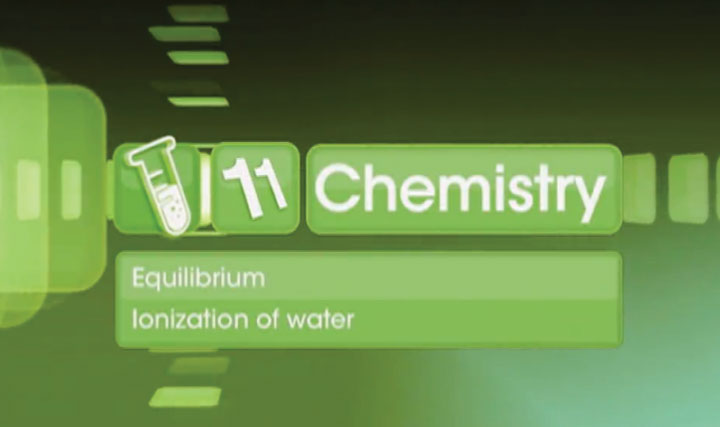
This video explains ionisation of water, ionic products of water and the dissociation constant of water.
-
Equilibrium
 This video explains the pH scale and the hydrolysis of salts.
This video explains the pH scale and the hydrolysis of salts. -
Equilibrium
 This video contains practice questions and numerical problems based on ionisation of water and pH.
This video contains practice questions and numerical problems based on ionisation of water and pH. -
Equilibrium
 This video explains solubility, factors influencing solubility, classification of solutes and solubility product.
This video explains solubility, factors influencing solubility, classification of solutes and solubility product. -
Equilibrium
 This video explains solubility product, molar solubility and contains numerical problems based on solubility product.
This video explains solubility product, molar solubility and contains numerical problems based on solubility product. -
Equilibrium
 This video contains practice questions and numerical problems on solubility products.
This video contains practice questions and numerical problems on solubility products. -
Equilibrium
 This video explains the concept of common ion effect.
This video explains the concept of common ion effect. -
Equilibrium
 This video explains criteria for precipitation and buffer solutions.
This video explains criteria for precipitation and buffer solutions. -
Equilibrium
 This video contains practice questions on common ion effect, precipitation and buffer solutions.
This video contains practice questions on common ion effect, precipitation and buffer solutions. -
Concepts on adsorption
 This video deals with the concepts on Adsorption.
This video deals with the concepts on Adsorption. -
Adsorption
 This video explains adsorption, enthalpy of addsorption, Gibbs free energy, Langmuir Isotherm, Freundlinch Isotherm
This video explains adsorption, enthalpy of addsorption, Gibbs free energy, Langmuir Isotherm, Freundlinch Isotherm -
Exam Prep Strategies on Adsorption
 This video is based on exam preparation strategies on Adsorption
This video is based on exam preparation strategies on Adsorption -
Catalysis
 This video explains about catalysis
This video explains about catalysis -
Catalysis
 This video explains about catalysis.
This video explains about catalysis. -
Chemistry Catalysis: Exam Prep Strategies
 This video explains about catalysis.
This video explains about catalysis. -
Emulsions
 This video includes definition of colloids, colloids based on dispersion phase and dispersion medium, preparation, properties and classification of emulsion
This video includes definition of colloids, colloids based on dispersion phase and dispersion medium, preparation, properties and classification of emulsion -
Colloids
 This video deals with the definition and classification of colloids based on the state of dispersion phase and the dispersion medium. This video also discusses the preparation, properties and classification of emulsions.
This video deals with the definition and classification of colloids based on the state of dispersion phase and the dispersion medium. This video also discusses the preparation, properties and classification of emulsions. -
Colloids
 This video explains Colloids, Classification o0f Colloids, Dispersion phase, Dispersion medium, Preparation and Classification of emulsions
This video explains Colloids, Classification o0f Colloids, Dispersion phase, Dispersion medium, Preparation and Classification of emulsions -
Properties of Colloids
 This video explains properties of colloids like Tyndall effect, Colour Brownian motion and Charge on colloidal particles, Coagulation of colloids and application colloids
This video explains properties of colloids like Tyndall effect, Colour Brownian motion and Charge on colloidal particles, Coagulation of colloids and application colloids -
Quick check on the Properties of colloids
 Properties of colloids like Tyndall effect, Colour Brownian motion and Charge on colloidal particles. Coagulation of colloids and application colloids.
Properties of colloids like Tyndall effect, Colour Brownian motion and Charge on colloidal particles. Coagulation of colloids and application colloids. -
Properties of Colloids: Exam Prep Strategies
 Properties of colloids like Tyndall effect, Colour Brownian motion and Charge on colloidal particles. Coagulation of colloids and application colloids
Properties of colloids like Tyndall effect, Colour Brownian motion and Charge on colloidal particles. Coagulation of colloids and application colloids -
About Colloids
 Classification based on type of particle Classification based on interaction of particles and the medium. Preparation and Purification of colloids.
Classification based on type of particle Classification based on interaction of particles and the medium. Preparation and Purification of colloids. -
Classification, preparation, purification of colloids
 Classification based on type of particle Classification based on interaction of particles and the medium. Preparation and Purification of colloids.
Classification based on type of particle Classification based on interaction of particles and the medium. Preparation and Purification of colloids. -
Types of Colloids: Exam Prep Strategies
 Classification based on type of particle Classification based on interaction of particles and the medium. Preparation and Purification of colloids.
Classification based on type of particle Classification based on interaction of particles and the medium. Preparation and Purification of colloids. -
Hydrogen
 This video explains the position of hydrogen in the periodic table and isotopes of hydrogen.
This video explains the position of hydrogen in the periodic table and isotopes of hydrogen. -
Hydrogen
 This video explains the occurrence, preparation, properties, uses of dihydrogen and classification of hydrides.
This video explains the occurrence, preparation, properties, uses of dihydrogen and classification of hydrides. -
Hydrogen
 This video contains practice questions on hydrogen and hydrides.
This video contains practice questions on hydrogen and hydrides. -
The p-Block Elements
 This video explains the electronic configuration and oxidation states of p-block elements.
This video explains the electronic configuration and oxidation states of p-block elements. -
The p-Block Elements
 This video explains inert pair effect, and the physical and chemical properties of Group 13 elements.
This video explains inert pair effect, and the physical and chemical properties of Group 13 elements. -
The p-Block Elements
 This video contains practice questions on electronic configuration, oxidation states of p-block elements, physical and chemical properties of Group 13 elements.
This video contains practice questions on electronic configuration, oxidation states of p-block elements, physical and chemical properties of Group 13 elements. -
The p-Block Elements

Study the Anomalous behaviour of first element of each group of p block, Physical and chemical properties of boron, Diagonal relationship with Silicon.
-
The p-Block Elements
 This video explains the physical and chemical properties of boron, and the diagonal relationship between boron and silicon.
This video explains the physical and chemical properties of boron, and the diagonal relationship between boron and silicon. -
The p-Block Elements
 This video contains practice questions on the anomalous behaviour of boron and the diagonal relationship between boron and silicon.
This video contains practice questions on the anomalous behaviour of boron and the diagonal relationship between boron and silicon. -
The p-Block Elements
 This video explains the appearance, preparation and uses of compounds of boron such as borax, boric acid and hydrides of boron.
This video explains the appearance, preparation and uses of compounds of boron such as borax, boric acid and hydrides of boron. -
The p-Block Elements
 This video explains the uses and chemical reactions of aluminium with acids and alkalis.
This video explains the uses and chemical reactions of aluminium with acids and alkalis. -
The p-Block Elements
 This video contains practice questions on compounds of boron and aluminium.
This video contains practice questions on compounds of boron and aluminium. -
The p-Block Elements
 This video explains the occurrence, electronic configuration of Group 14 elements and trend in atomic and ionic radii of Group 14 elements.
This video explains the occurrence, electronic configuration of Group 14 elements and trend in atomic and ionic radii of Group 14 elements. -
The p-Block Elements
 This video explains the comparison between the trends in properties of Group 13 and 14 elements, trend of ionisation enthalpy in Group 14 elements and the uses of Group 14 elements.
This video explains the comparison between the trends in properties of Group 13 and 14 elements, trend of ionisation enthalpy in Group 14 elements and the uses of Group 14 elements. -
The p-Block Elements
 This video contains practice questions on Group 14 elements.
This video contains practice questions on Group 14 elements. -
The p-Block Elements
 This video explains the properties of carbon and graphite, a crystalline form of carbon.
This video explains the properties of carbon and graphite, a crystalline form of carbon. -
The p-Block Elements
 This video explains the crystalline allotropes of carbon, i.e. carbon and fullerene, and the amorphous forms of carbon.
This video explains the crystalline allotropes of carbon, i.e. carbon and fullerene, and the amorphous forms of carbon. -
The p-Block Elements
 This video contains practice questions on the allotropes of carbon.
This video contains practice questions on the allotropes of carbon. -
The p-Block Elements
 This video explains the properties and uses of silicon, the structure and uses of silica and the structure of silicates.
This video explains the properties and uses of silicon, the structure and uses of silica and the structure of silicates. -
The p-Block Elements
 This video explains the types of silicates, and the preparation and properties of silicones.
This video explains the types of silicates, and the preparation and properties of silicones. -
The p-Block Elements
 This video contains practice questions on compounds of silicon.
This video contains practice questions on compounds of silicon. -
Halogens
 This video describes preparation, properties and uses of chlorine, preparation, properties and uses of Hydrochloric acid, oxoacids of halogens, Interhalogen compounds
This video describes preparation, properties and uses of chlorine, preparation, properties and uses of Hydrochloric acid, oxoacids of halogens, Interhalogen compounds -
More on Halogens
 Halogens.
Halogens. -
Halogens
 This video is a problem solving video related to halogens.
This video is a problem solving video related to halogens. -
p-Block Elements - Nitrogen
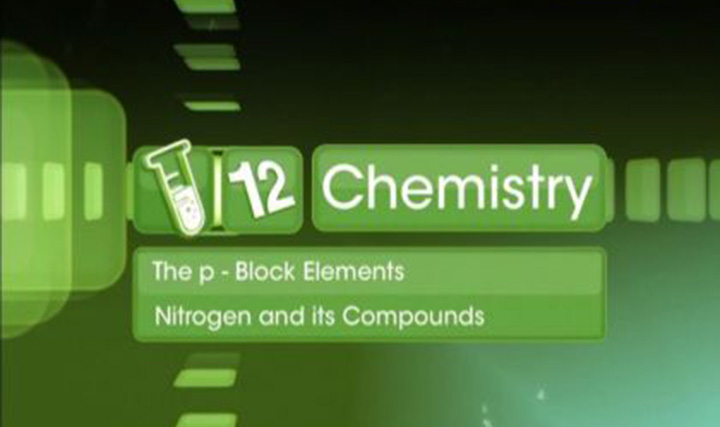 Describes preparation, properties and uses of dinitrogen, ammonia and nitric acid
Describes preparation, properties and uses of dinitrogen, ammonia and nitric acid -
Nitrogen and its compounds
 Describes preparation, properties and uses of dinitrogen, ammonia and nitric acid
Describes preparation, properties and uses of dinitrogen, ammonia and nitric acid -
Nitrogen and its Compounds
 This video describes preparation, properties and uses of dinitrogen, ammonia and nitric acid
This video describes preparation, properties and uses of dinitrogen, ammonia and nitric acid -
Oxygen
 This video explains preparation, properties and uses of oxygen and ozone. Study of various oxides- acidic, basic, amphoteric and neutral oxides.
This video explains preparation, properties and uses of oxygen and ozone. Study of various oxides- acidic, basic, amphoteric and neutral oxides. -
Oxygen
 This video exlplains describes preparation, properties and uses of oxygen and Ozone and study of various oxides.
This video exlplains describes preparation, properties and uses of oxygen and Ozone and study of various oxides. -
Oxygen
 This video describes the preparation, properties of Oxygen. It also covers the information related to various oxides.
This video describes the preparation, properties of Oxygen. It also covers the information related to various oxides. -
Phosphorus and its Compounds
 This video explains allotropic forms of Phosphorus, Preparation and properties of Phosphine, Phosphorous halides and Phosphorous oxoacids
This video explains allotropic forms of Phosphorus, Preparation and properties of Phosphine, Phosphorous halides and Phosphorous oxoacids -
More on allotropic forms of phosphorous
 Study of allotropic forms of phosphorous, preparation and properties of phosphine, phosphorous halides and phosphorous oxoacids.
Study of allotropic forms of phosphorous, preparation and properties of phosphine, phosphorous halides and phosphorous oxoacids. -
Carbohydrate
 This video explains about reducing and non-reducing sugar, chemicalproperties of Glucose, Role of carbohydrate.
This video explains about reducing and non-reducing sugar, chemicalproperties of Glucose, Role of carbohydrate. -
Trends in properties of P-block elements
 This video gives a general introduction to group 15, 16 and 17 elements along with trends in physical and chemical properties.
This video gives a general introduction to group 15, 16 and 17 elements along with trends in physical and chemical properties. -
Physical and chemical properties of group 15, 16, 17 elements
 Gives general introduction to group 15, 16 and 17 along with trends in physical and chemical properties.
Gives general introduction to group 15, 16 and 17 along with trends in physical and chemical properties. -
Trends In Properties Of P Block: Exam Prep Strategies
 Gives general introduction to group 15, 16 and 17 along with trends in physical and chemical properties.
Gives general introduction to group 15, 16 and 17 along with trends in physical and chemical properties. -
Formation of interstitial compounds of d block elements
 This video discusses the important compounds of d block elements.
This video discusses the important compounds of d block elements. -
Important Compounds of d Block
 This video explains important compounds of d block
This video explains important compounds of d block -
Exam prep strategies on compounds of d block elements
 This video discusses the important compounds of d block elements.
This video discusses the important compounds of d block elements. -
Introduction d-block elements
 This video explains about Classification of d Block elements into transition series, General properties of d - block elements: variable oxidation states, coloured ions.
This video explains about Classification of d Block elements into transition series, General properties of d - block elements: variable oxidation states, coloured ions. -
Introduction to d-Block Elements
 This video explains classification of d block elements into transition series, General Properties of d-block elements, variable oxidation states
This video explains classification of d block elements into transition series, General Properties of d-block elements, variable oxidation states -
Classification of d Block elements into transition series
 Classification of d Block elements into transition series,General properties of d - block elements: variable oxidation states, coloured ions.
Classification of d Block elements into transition series,General properties of d - block elements: variable oxidation states, coloured ions. -
About Lanthanoids and Actinoids
 This video explains about the d and f block elements.
This video explains about the d and f block elements. -
Concepts of Lanthanoids and Actinoids
 This video explains the crucial concepts of Lanthanoids and Actinoids.
This video explains the crucial concepts of Lanthanoids and Actinoids. -
Lathanoids and Actinoids
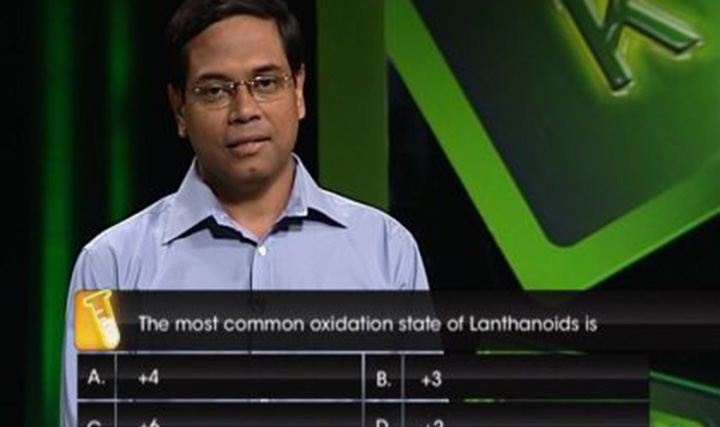 This video explains problem-solving related to properties of Lanthanoids and Actinoids. It also provides a piece of information related to their differences.
This video explains problem-solving related to properties of Lanthanoids and Actinoids. It also provides a piece of information related to their differences. -
Study of properties of d block elements
 Study of properties of d block elements like melting points, atomic size, ionisation enthalpy, oxidation states, chemical reactivity, magnetic properties, complex formation & catalytic properties.
Study of properties of d block elements like melting points, atomic size, ionisation enthalpy, oxidation states, chemical reactivity, magnetic properties, complex formation & catalytic properties. -
Properties of d-block elements
 Study of properties of d block elements like melting points, atomic size, ionisation enthalpy, oxidation states, chemical reactivity, magnetic properties, complex formation & catalytic properties.
Study of properties of d block elements like melting points, atomic size, ionisation enthalpy, oxidation states, chemical reactivity, magnetic properties, complex formation & catalytic properties. -
Properties of d Block Elements: Exam Prep Strategies
 Study of properties of d block elements like melting points, atomic size, ionisation enthalpy, oxidation states, chemical reactivity, magnetic properties, complex formation & catalytic properties.
Study of properties of d block elements like melting points, atomic size, ionisation enthalpy, oxidation states, chemical reactivity, magnetic properties, complex formation & catalytic properties. -
Environmental Chemistry
 The video explains the formation and depletion of the ozone layer.
The video explains the formation and depletion of the ozone layer. -
Environmental Chemistry
 This video explains the greenhouse effect and global warming.
This video explains the greenhouse effect and global warming. -
Environmental Chemistry
 This video contains practice questions on ozone depletion, greenhouse effect and global warming.
This video contains practice questions on ozone depletion, greenhouse effect and global warming. -
Environmental Pollution
 This video explains about environmental polllution and pollutants.
This video explains about environmental polllution and pollutants. -
Introduction to Atmospheric Pollution
 This video explains about atmospheric pollution and different layers of atmosphere.
This video explains about atmospheric pollution and different layers of atmosphere. -
Gaseous Air Pollutants
 This video explains about different gaseous air pollutants in atmosphere.
This video explains about different gaseous air pollutants in atmosphere. -
Simple Distillation
 This video explains the principle and process of simple distillation.
This video explains the principle and process of simple distillation. -
Distillation under reduced pressure

This video explains the principle and process of Distillation under reduced pressure
-
An Introduction to chromatography
 This video includes basic information related to chromatography and their types.
This video includes basic information related to chromatography and their types. -
Adsorption Chromatography
 This video includes basic information related to adsorption chromatography and their types.
This video includes basic information related to adsorption chromatography and their types. -
Column chrmoatography
 This video explains about principle and process of column chromatography.
This video explains about principle and process of column chromatography. -
Partition Chromatography
 This video explains about principle and process of partition chromatography.This video explains about principle and process of column chromatography.
This video explains about principle and process of partition chromatography.This video explains about principle and process of column chromatography. -
Mechanism of addition polymerisation
 This video explains addition and condensation polymers.
This video explains addition and condensation polymers. -
All about polymers
 This video discusses addition and condensation polymers.
This video discusses addition and condensation polymers. -
Exam Strategies on Addition and Condensation Polymers

This video explains polymerisation and helps with a quick revision on addition and condensation polymers.
-
Polymer classification and related concepts
 This video explains the classification of Polymers.
This video explains the classification of Polymers. -
Various classification of polymers
 This video explains various classification of polymers.
This video explains various classification of polymers. -
Classification of polymers
 Classification of polymers
Classification of polymers -
Food Additives - Chemicals in our food
 This Video explains about food additives and cleansing agents.
This Video explains about food additives and cleansing agents. -
About food additives and cleansing agents
 Food additives and cleansing agents
Food additives and cleansing agents -
Exam prep strategies on food additives and cleansing agents
 This video focuses on the exam prep strategies of Food additives and cleansing agents.
This video focuses on the exam prep strategies of Food additives and cleansing agents. -
Therapeutic action of drugs - Part 1
 This video explains therapeutic action of drugs.
This video explains therapeutic action of drugs. -
Therapeutic action of drugs - Part 2
 The video explains therapeutic action of drugs.
The video explains therapeutic action of drugs. -
Therapeutic Action of drugs
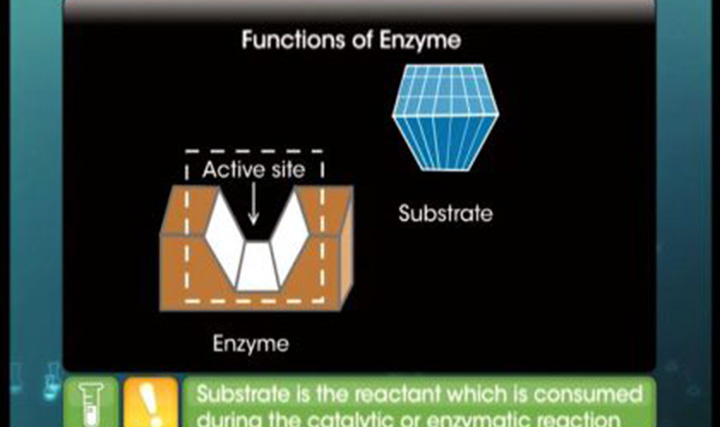 Problem solving and strategy session on therapeutic action of drugs.
Problem solving and strategy session on therapeutic action of drugs. -
Drugs and their Classification
 This video covers introduction about drugs and classification of drugs in terms of pharmacological effect, drug action, chemical nature.
This video covers introduction about drugs and classification of drugs in terms of pharmacological effect, drug action, chemical nature. -
Drug target interaction
 This video is an introduction to drug-target interaction.
This video is an introduction to drug-target interaction. -
Antaacids
 This video provides important information related to Antacids.
This video provides important information related to Antacids. -
Antihistamines
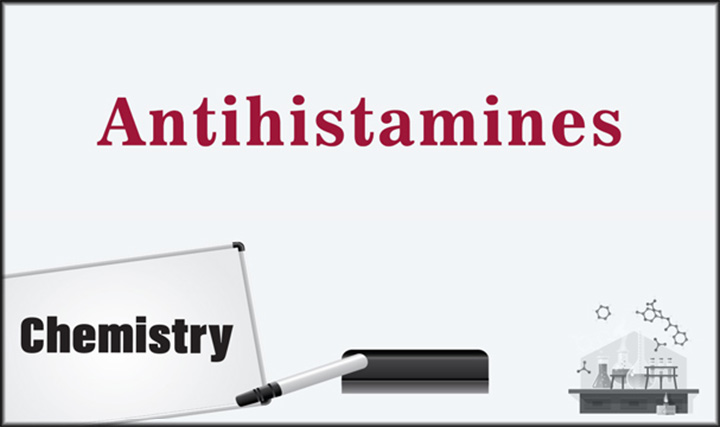 This video provides important information related to Antihistamines.
This video provides important information related to Antihistamines. -
Neurologically active drugs-I
 This video provides important information related to tranquilizers.
This video provides important information related to tranquilizers. -
Neurologically active drugs-II
 This video provides important information related to analgesics.
This video provides important information related to analgesics. -
Antibiotics
 This video provides important information related to antibiotics.
This video provides important information related to antibiotics. -
Antiseptics and Disinfectants
 This video provides important information related to antiseptics and disinfectants.
This video provides important information related to antiseptics and disinfectants. -
Antifertile Drugs
 This video provides important information related to antifertility drugs.
This video provides important information related to antifertility drugs. -
Receptor as Drug Targets
 This video explains the process when receptors as drug targets.
This video explains the process when receptors as drug targets. -
Enzyme as Drug Targets II
 This video explains about interaction of enzyme and drug, inhibitors and allosteric site.
This video explains about interaction of enzyme and drug, inhibitors and allosteric site. -
Enzyme as Drug Targets I
 This video explains about process of catalytic action of enzymes.
This video explains about process of catalytic action of enzymes. -
Structure of Atom
 This video explains Dalton's atomic theory, discovery of electrons, protons and neutrons.
This video explains Dalton's atomic theory, discovery of electrons, protons and neutrons. -
Atomic Models
 This video explains Thomson's model of an atom, Rutherford's model, atomic number, mass number, isotopes and isobars.
This video explains Thomson's model of an atom, Rutherford's model, atomic number, mass number, isotopes and isobars. -
Structure of Atom
 This video contains practice questions on Dalton's atomic theory, discovery of subatomic particles, atomic models, atomic number, mass number, isotopes and isobars.
This video contains practice questions on Dalton's atomic theory, discovery of subatomic particles, atomic models, atomic number, mass number, isotopes and isobars. -
Structure of Atom
 This video explains electromagnetic radiations and black body radiations.
This video explains electromagnetic radiations and black body radiations. -
Structure of Atom
 This video explains Planck's quantum theory and photoelectric effect.
This video explains Planck's quantum theory and photoelectric effect. -
Structure of Atom
 This video contains practice questions and numerical problems on electromagnetic radiations, black body radiations, Planck's quantum theory and photoelectric effect.
This video contains practice questions and numerical problems on electromagnetic radiations, black body radiations, Planck's quantum theory and photoelectric effect. -
Structure of Atom
 This video explains atomic spectra.
This video explains atomic spectra. -
Structure of Atom
 This video explains the line spectrum of hydrogen, Bohr's model for hydrogen atom and limitations of Bohr's model for hydrogen atom.
This video explains the line spectrum of hydrogen, Bohr's model for hydrogen atom and limitations of Bohr's model for hydrogen atom. -
Structure of Atom
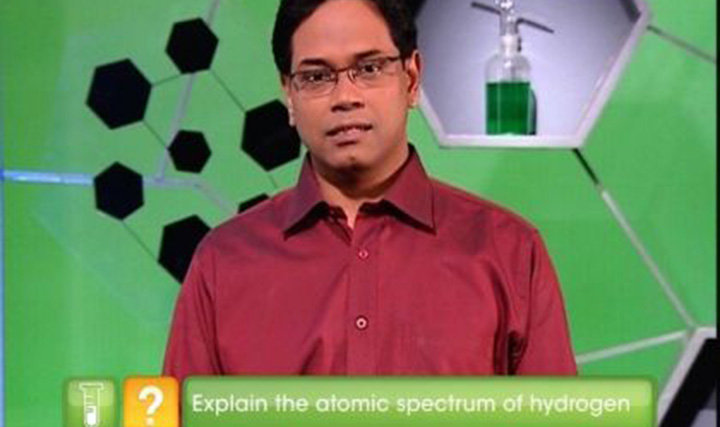 This video contains practice questions and numerical problems on atomic spectra, line spectrum of hydrogen and Bohr's atomic model of hydrogen.
This video contains practice questions and numerical problems on atomic spectra, line spectrum of hydrogen and Bohr's atomic model of hydrogen. -
Dual Nature of Radiation and Matter
 This video explains the dual nature of radiation and matter by de Broglie’s theory.
This video explains the dual nature of radiation and matter by de Broglie’s theory. -
Structure of Atom
 This video explains Heisenberg's uncertainty principle and contains numerical problems based on it and de Broglie’s theory.
This video explains Heisenberg's uncertainty principle and contains numerical problems based on it and de Broglie’s theory. -
Structure of Atom
 This video contains practice questions based on the de Broglie's theory and Heisenberg's uncertainty principle.
This video contains practice questions based on the de Broglie's theory and Heisenberg's uncertainty principle. -
Structure of Atom
 This video explains shapes of atomic orbitals, Aufbau principle and Pauli's exclusion principle.
This video explains shapes of atomic orbitals, Aufbau principle and Pauli's exclusion principle. -
Structure of Atom
 This video explains Hund's rule of maximum multiplicity, electronic configuration, exceptional electronic configuration and stability of half and completely filled subshells.
This video explains Hund's rule of maximum multiplicity, electronic configuration, exceptional electronic configuration and stability of half and completely filled subshells. -
Structure of Atom
 This video contains practice questions on electronic configurations of atoms.
This video contains practice questions on electronic configurations of atoms. -
About quantum mechanical model of an atom
 Conceptualise the quantum mechanical model of an atom and understand the concept of orbital in terms of quantum numbers.
Conceptualise the quantum mechanical model of an atom and understand the concept of orbital in terms of quantum numbers. -
Quantum Mechanical Model of an Atom
 This video Conceptualise the quantum mechanical model of an atom. You will also understand the concept of orbital in terms of quantum numbers.
This video Conceptualise the quantum mechanical model of an atom. You will also understand the concept of orbital in terms of quantum numbers. -
Quantum mechanical model of an atom
 Conceptualise the quantum mechanical model of an atom and understand the concept of orbital in terms of quantum numbers.
Conceptualise the quantum mechanical model of an atom and understand the concept of orbital in terms of quantum numbers. -
Bohr Orbits in H-atoms
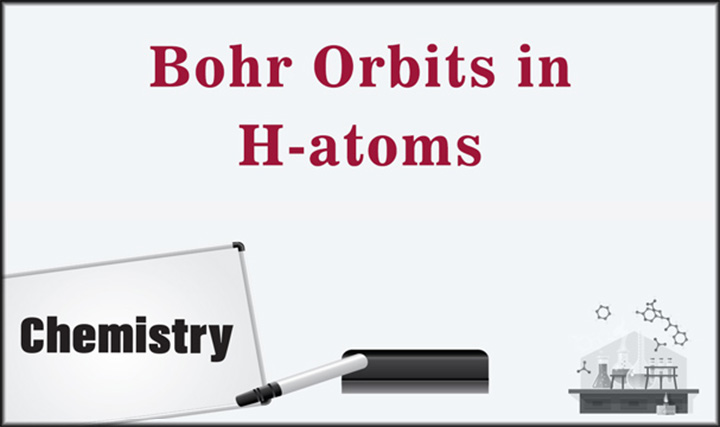
This video explains the derivation of Bohr's radius, velocity and energy in the atom.
-
Aufbau Principle

This video explains about Aufbau's principle, (n+l) rule and problem-related to (n+l) rule.
-
Problems Related to Quantum Numbers

This video explains problem solving approach to solve questions related to Quamntum Numbers.
-
Classification of Carbohydrates
 This video deals with carbohydrates, its classification, glucose and its structure and importance of carbohydrates.
This video deals with carbohydrates, its classification, glucose and its structure and importance of carbohydrates. -
Carbohydrate
 This video explains about reducing and non-reducing sugar, chemicalproperties of Glucose, Role of carbohydrate.
This video explains about reducing and non-reducing sugar, chemicalproperties of Glucose, Role of carbohydrate. -
Carbohydrates
 Carbohydrates
Carbohydrates -
DNA and RNA
 This Video explains chemical composition nucleic acids, structure of nucleic acids, biological functins of nucleic acids.
This Video explains chemical composition nucleic acids, structure of nucleic acids, biological functins of nucleic acids. -
About the Biomolecules - DNA and RNA
 This video explains the about DNA, RNA.
This video explains the about DNA, RNA. -
DNA and RNA
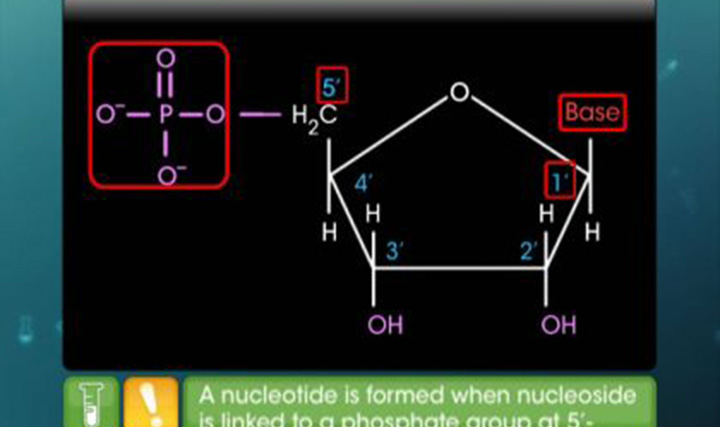 This video explains sproblem solving related to DNA and RNA.
This video explains sproblem solving related to DNA and RNA. -
Proteins and Enzymes
 This video explains study of Amino acids, their classification, Proteins and their structure, denaturation of proteins, enzymes and mechanism of enzyme action
This video explains study of Amino acids, their classification, Proteins and their structure, denaturation of proteins, enzymes and mechanism of enzyme action -
Proteins and Enzymes
 This video explains study of Amino acids, their classification, Proteins and their structure, denaturation of proteins, enzymes and mechanism of enzyme action
This video explains study of Amino acids, their classification, Proteins and their structure, denaturation of proteins, enzymes and mechanism of enzyme action -
Proteins and Enzymes
 Study of amino Acids, their classification, Proteins and their structure, denaturation of proteins, Enzymes and mechanism of enzyme action
Study of amino Acids, their classification, Proteins and their structure, denaturation of proteins, Enzymes and mechanism of enzyme action -
Ionic Bonding
 This video is based on the concept of Valence electrons, octet rule, covalent bond and Lewis structure.
This video is based on the concept of Valence electrons, octet rule, covalent bond and Lewis structure. -
Covalent Bonds
 This video explains concept of valence electrons, octet rule, covalent bond and lewis structure.
This video explains concept of valence electrons, octet rule, covalent bond and lewis structure. -
Chemical Bonding and Molecular Structure
 This video we will discuss the concept of Valence electrons, octet rule, covalent bond and Lewis structure.
This video we will discuss the concept of Valence electrons, octet rule, covalent bond and Lewis structure. -
Chemical Bonding and Molecular Structure
 This video explains ionic bonding, ionisation enthalpy, electron gain enthalpy and lattice enthalpy.
This video explains ionic bonding, ionisation enthalpy, electron gain enthalpy and lattice enthalpy. -
Chemical Bonding and Molecular Structure
 This video explains the dipole moment in polar bonds.
This video explains the dipole moment in polar bonds. -
Chemical Bonding and Molecular Structure
 This video contains practice questions on ionic bond and dipole moment.
This video contains practice questions on ionic bond and dipole moment. -
Chemical Bonding and Molecular Structure
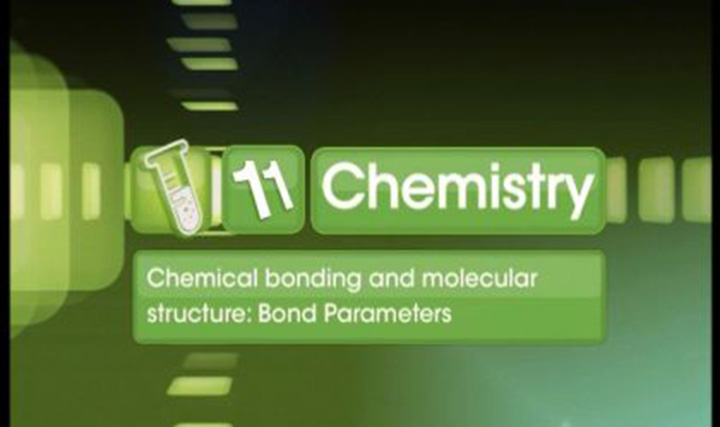 This video explains the meaning and significance of bond parameters such as bond length, its effect on bond stability and bond angle.
This video explains the meaning and significance of bond parameters such as bond length, its effect on bond stability and bond angle. -
Chemical Bonding and Molecular Structure
 This video explains the meaning and significance of bond enthalpy and the calculation of enthalpy of a chemical reaction.
This video explains the meaning and significance of bond enthalpy and the calculation of enthalpy of a chemical reaction. -
Chemical Bonding and Molecular Structure
 This video contains practice questions on bond parameters such as bond length, bond angle and bond enthalpy.
This video contains practice questions on bond parameters such as bond length, bond angle and bond enthalpy. -
Concepts of Hybridisation at a molecular level.
 Valence bond theory and overlapping of atomic orbitals. Understand the concept of hybridization, involving s, p and d orbitals.
Valence bond theory and overlapping of atomic orbitals. Understand the concept of hybridization, involving s, p and d orbitals. -
Valence Bond Theory and Hybridisation
 This video explains about valennce bond theory and overlapping of atomic orbitals, undersatand the concept of hybridisation, involving s,p,d and f orbitals.
This video explains about valennce bond theory and overlapping of atomic orbitals, undersatand the concept of hybridisation, involving s,p,d and f orbitals. -
Hybridisation
 This video focuses on the Valence bond theory and overlapping of atomic orbitals. You will also understand the concept of hybridization, involving s, p and d orbitals.
This video focuses on the Valence bond theory and overlapping of atomic orbitals. You will also understand the concept of hybridization, involving s, p and d orbitals. -
Chemical Bonding and Molecular Structure
 This video explains the valence shell electron pair repulsion (VSEPR) theory and describes the shapes and geometries formed by chemical bonding of some important molecules.
This video explains the valence shell electron pair repulsion (VSEPR) theory and describes the shapes and geometries formed by chemical bonding of some important molecules. -
Chemical Bonding and Molecular Structure
 This video contains examples of geometry and shapes of some molecules and a concept test.
This video contains examples of geometry and shapes of some molecules and a concept test. -
Chemical Bonding and Molecular Structure
 This video contains practice questions on VSEPR theory and geometry and shapes of molecules.
This video contains practice questions on VSEPR theory and geometry and shapes of molecules. -
Chemical Bonding and Molecular Structure
 This video explains hydrogen bonding, its effects on the properties of molecules and the anomalous properties of water.
This video explains hydrogen bonding, its effects on the properties of molecules and the anomalous properties of water. -
Chemical Bonding and Molecular Structure
 This video explains the concept of resonance.
This video explains the concept of resonance. -
Chemical Bonding and Molecular Structure
 This video contains practice questions on hydrogen bonding, anomalous properties of water and resonance.
This video contains practice questions on hydrogen bonding, anomalous properties of water and resonance. -
Chemical Bonding and Molecular Structure
 This video explains the molecular orbital theory, rules for writing the electronic configuration of molecules and electronic configuration of homonuclear diatomic molecules.
This video explains the molecular orbital theory, rules for writing the electronic configuration of molecules and electronic configuration of homonuclear diatomic molecules. -
Chemical Bonding and Molecular Structure
 This video explains the applications of molecular orbital theory.
This video explains the applications of molecular orbital theory. -
Chemical Bonding and Molecular Structure
 This video contains practice questions on molecular orbital theory and electronic configuration of molecules.
This video contains practice questions on molecular orbital theory and electronic configuration of molecules. -
Collision Theory
 This video explains collision theory, effective and ineffective collision.
This video explains collision theory, effective and ineffective collision. -
Collision Theory
 This video explains collision theory, collision frequency, Arhenius equation.
This video explains collision theory, collision frequency, Arhenius equation. -
Collision Theory
 This video includes information related to Collision Theory.
This video includes information related to Collision Theory. -
Integrated Rate Equation
 This video explains the derivation of integrated rate equation and calculate half life for zero order reaction, first order reaction and pseudo order reaction.
This video explains the derivation of integrated rate equation and calculate half life for zero order reaction, first order reaction and pseudo order reaction. -
Deriving integrated rate equation and calculate half life for zero order and first order reaction
 Derive integrated rate equation and calculate half life for zero order and first order reaction. Define pseudo order reactions.
Derive integrated rate equation and calculate half life for zero order and first order reaction. Define pseudo order reactions. -
Integrated Rate Equation
 This video explains derrive integrated rate equation, half life of zero and first order of reaction, definition of pseudo order reaction.
This video explains derrive integrated rate equation, half life of zero and first order of reaction, definition of pseudo order reaction. -
Order and Molecularity of Reaction
 This video explains effect of concentration of reactant of reaction, rate law, Order and Molecularity of reaction, Elementary of complex reaction
This video explains effect of concentration of reactant of reaction, rate law, Order and Molecularity of reaction, Elementary of complex reaction -
Order and Molecularity of Reaction
 This video explains effect of concentrations of reactant on rate of reaction, rate law, Order and Molecularty of reaction, Elementary and Complex reactions
This video explains effect of concentrations of reactant on rate of reaction, rate law, Order and Molecularty of reaction, Elementary and Complex reactions -
Order and Molecularity of Reaction
 This video includes problems related to effect of concentration of reactant on rate of reaction, rate law, Order and Molecularity of reaction, Elementary and Complex reaction.
This video includes problems related to effect of concentration of reactant on rate of reaction, rate law, Order and Molecularity of reaction, Elementary and Complex reaction. -
Calculate rate of reactions
 Define and calculate rate, average & instantaneous rate. Express rate of reaction in terms of stoichiometric coefficients.
Define and calculate rate, average & instantaneous rate. Express rate of reaction in terms of stoichiometric coefficients. -
Rate of a Chemical Reaction
 This video explains rate of reaction, average rate, instantaneous rate .
This video explains rate of reaction, average rate, instantaneous rate . -
More on rate of a chemical reaction n chemical kinetics
 Define and calculate rate, average & instantaneous rate. Express rate of reaction in terms of psychometric coefficients.
Define and calculate rate, average & instantaneous rate. Express rate of reaction in terms of psychometric coefficients. -
Temperature dependence of reaction
 This video describes the effect of temperature and use of catalyst on the rate of reactions.
This video describes the effect of temperature and use of catalyst on the rate of reactions. -
Rate of Reactions
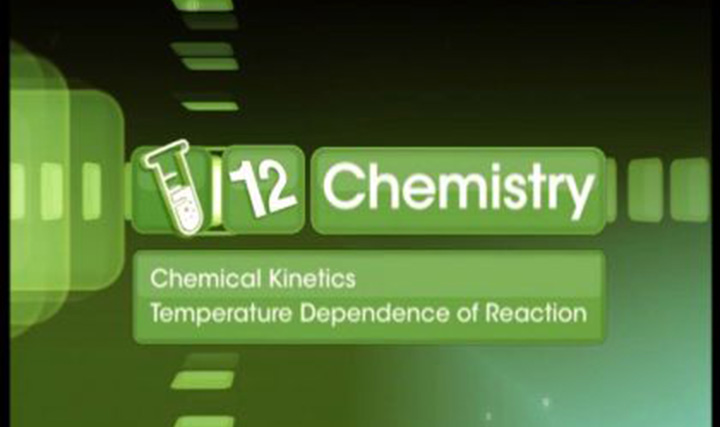 This video describes the effect of temperature and use of catalyst on rate of reactions.
This video describes the effect of temperature and use of catalyst on rate of reactions. -
Effect of Temperature and Catalyst on Rate oif Reaction
 This video contains problems related to the effect of temperature and use of catalyst on rate of reaction
This video contains problems related to the effect of temperature and use of catalyst on rate of reaction -
Thermodynamics
 This video explains specific heat capacity, heat capacity at constant pressure Cp and constant volume Cv, and relation between Cp and Cv for an ideal gas.
This video explains specific heat capacity, heat capacity at constant pressure Cp and constant volume Cv, and relation between Cp and Cv for an ideal gas. -
Thermodynamics
 This video explains the measurement of change in internal energy (?U) and enthalpy (?H).
This video explains the measurement of change in internal energy (?U) and enthalpy (?H). -
Thermodynamics
 This video contains practice questions and numerical problems on measurement of change in internal energy (?U) and enthalpy (?H).
This video contains practice questions and numerical problems on measurement of change in internal energy (?U) and enthalpy (?H). -
Thermodynamics
 This video explains the meaning of enthalpy, enthalpy of formation and enthalpy of combustion.
This video explains the meaning of enthalpy, enthalpy of formation and enthalpy of combustion. -
Thermodynamics
 This video explains enthalpies of bond dissociation, phase change, solution, thermochemical equation and Hess's law.
This video explains enthalpies of bond dissociation, phase change, solution, thermochemical equation and Hess's law. -
Thermodynamics
 This video contains practice questions and numerical problems on types of enthalpy changes, thermochemical equation and Hess's law.
This video contains practice questions and numerical problems on types of enthalpy changes, thermochemical equation and Hess's law. -
Enthalpy of Solution
 Defining enthalpy of solution, enthalpy of fusion and vaporisation. Using Born-Haber cycle calculates lattice enthalpy of ionic compounds.
Defining enthalpy of solution, enthalpy of fusion and vaporisation. Using Born-Haber cycle calculates lattice enthalpy of ionic compounds. -
Thermodynamics
 This video contains practice questions and numerical problems based on enthalpy change and Born-Haber cycle.
This video contains practice questions and numerical problems based on enthalpy change and Born-Haber cycle. -
Thermodynamics
 This video explains spontaneity, enthalpy change and calculations of change in entropy.
This video explains spontaneity, enthalpy change and calculations of change in entropy. -
Thermodynamics
 This video explains the relation between entropy and spontaneity, Gibbs energy and spontaneity, Gibbs energy change and equilibrium.
This video explains the relation between entropy and spontaneity, Gibbs energy and spontaneity, Gibbs energy change and equilibrium. -
Thermodynamics
 This video contains practice questions and numerical problems on entropy and Gibbs energy.
This video contains practice questions and numerical problems on entropy and Gibbs energy. -
Thermodynamics
 This video explains the enthalpy of phase change, enthalpy of sublimation and enthalpy of ionisation.
This video explains the enthalpy of phase change, enthalpy of sublimation and enthalpy of ionisation. -
Periodic Classification of Elements
 This video explains Dobereiner's triads, Newland's law of octaves and Mendeleev's periodic classification.
This video explains Dobereiner's triads, Newland's law of octaves and Mendeleev's periodic classification. -
Periodic Classification of Elements
 This video explains the limitations of Mendeleev's periodic table, development of modern periodic law and the modern periodic table.
This video explains the limitations of Mendeleev's periodic table, development of modern periodic law and the modern periodic table. -
Periodic Classification of Elements
 This video contains practice questions based on the periodic classification of elements.
This video contains practice questions based on the periodic classification of elements. -
Periodic Classification of Elements
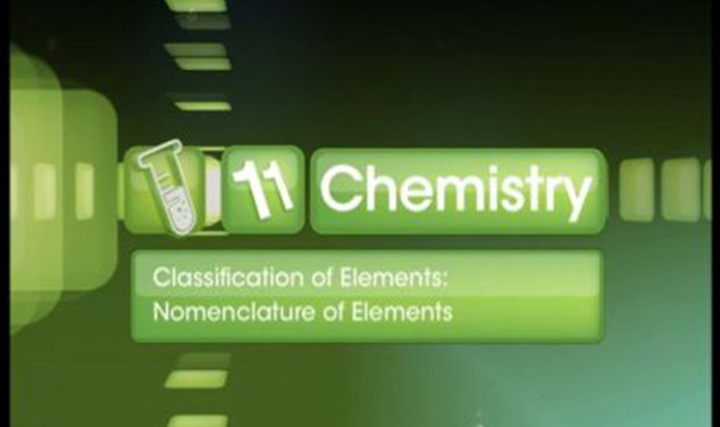 This video explains the nomenclature of elements with atomic number above 100 and the arrangement of electrons in specific orders in orbitals (n+l rule).
This video explains the nomenclature of elements with atomic number above 100 and the arrangement of electrons in specific orders in orbitals (n+l rule). -
Periodic Classification of Elements
 This video explains period-wise electronic configuration, electronic configurations of the lanthanoid and actinoid series, and the order of subshells in the periodic table.
This video explains period-wise electronic configuration, electronic configurations of the lanthanoid and actinoid series, and the order of subshells in the periodic table. -
Periodic Classification of Elements
 This video contains practice questions on IUPAC nomenclature and electronic configuration of elements.
This video contains practice questions on IUPAC nomenclature and electronic configuration of elements. -
Periodic Classification of Elements
 This video introduces the s-, p-, d- and f-blocks of the periodic table and explains the elements of the s-block.
This video introduces the s-, p-, d- and f-blocks of the periodic table and explains the elements of the s-block. -
Periodic Classification of Elements
 This video explains p-block elements, f-block elements (inner transition metals) and the position of metals, non-metals, metalloids in the periodic table.
This video explains p-block elements, f-block elements (inner transition metals) and the position of metals, non-metals, metalloids in the periodic table. -
Periodic Classification of Elements
 This video contains practice questions on the four blocks in the periodic table.
This video contains practice questions on the four blocks in the periodic table. -
Periodic Classification of Elements
 This video explains trends in the atomic radii of elements in the periodic table.
This video explains trends in the atomic radii of elements in the periodic table. -
Periodic Classification of Elements
 This video explains trends in the ionic radii, ionisation energy, electron affinity and electronegativity of elements in the periodic table.
This video explains trends in the ionic radii, ionisation energy, electron affinity and electronegativity of elements in the periodic table. -
Periodic Classification of Elements
 This video contains practice questions on the trends in properties of elements in the periodic table.
This video contains practice questions on the trends in properties of elements in the periodic table. -
Periodic Classification of Elements
 This video explains the trends in the periodicity of valance or oxidation states of representative elements in the periodic table.
This video explains the trends in the periodicity of valance or oxidation states of representative elements in the periodic table. -
Periodic Classification of Elements
 This video explains the trends in the periodicity of valance or oxidation states of transition elements, periodic trends in chemical reactivity, and the anomalous properties of the second period elements and the first member of a group.
This video explains the trends in the periodicity of valance or oxidation states of transition elements, periodic trends in chemical reactivity, and the anomalous properties of the second period elements and the first member of a group. -
Periodic Classification of Elements
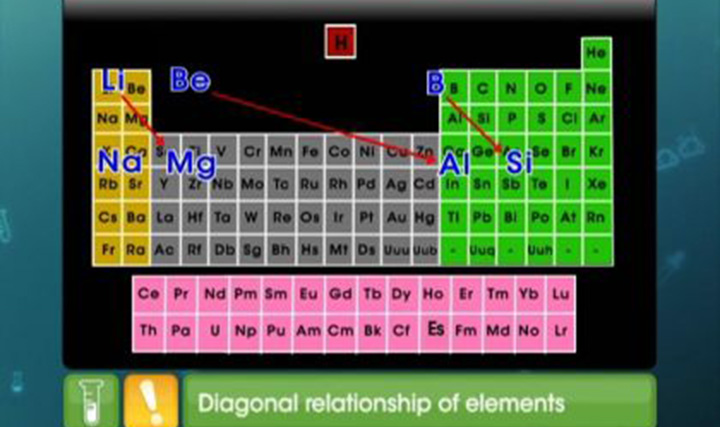 This video contains practice questions on the trends in chemical properties of elements in the periodic table.
This video contains practice questions on the trends in chemical properties of elements in the periodic table. -
An Introduction to Coordination Compounds
 This video explains about types of ligands and coordination number.
This video explains about types of ligands and coordination number. -
Introduction to coordination compounds
 This video explains Coordination compounds, Types of ligands, Coordination number.
This video explains Coordination compounds, Types of ligands, Coordination number. -
Introduction to Coordination Compounds
 This video explains problems related to coordination compounds, types of ligands, coordination number
This video explains problems related to coordination compounds, types of ligands, coordination number -
Occurrence and Extraction
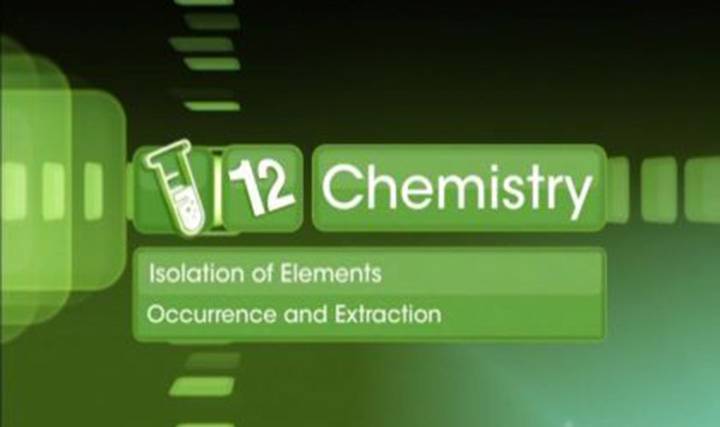 This video explains the occurrence of metals in nature as minerals and steps involved in metallurgy.
This video explains the occurrence of metals in nature as minerals and steps involved in metallurgy. -
Occurrence and Extraction
 This video explains occurrence of metals as minerals, extraction of metal from ore.
This video explains occurrence of metals as minerals, extraction of metal from ore. -
Occurrence and Extraction
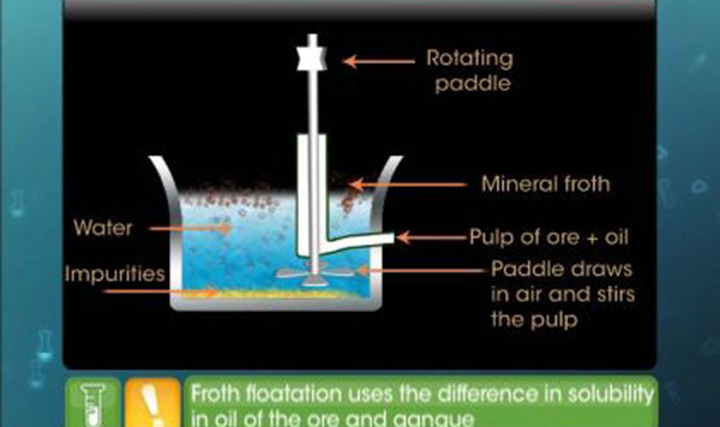 This video contains problems to understand the occurrence of metals in nature as minerals and explains steps involved in metallurgy for extraction of the metal from its ore
This video contains problems to understand the occurrence of metals in nature as minerals and explains steps involved in metallurgy for extraction of the metal from its ore -
Principles of Metallurgy
 This video explains thermodynamic and electrochemical principles involved in reduction process and Ellingham diagram
This video explains thermodynamic and electrochemical principles involved in reduction process and Ellingham diagram -
Reduction Process and Ellingham Diagram
 This video explains thermodynamic and electrochemical principles involved in reduction process and Ellingham diagram
This video explains thermodynamic and electrochemical principles involved in reduction process and Ellingham diagram -
Thermodynamic Principles of Metallurgy
 This video includes Thermodynamic and electrochemical principles involved in reduction process and Ellingham diagram.
This video includes Thermodynamic and electrochemical principles involved in reduction process and Ellingham diagram. -
Hydrocarbons
 This video gives an overview of hydrocarbons and alkanes.
This video gives an overview of hydrocarbons and alkanes. -
Hydrocarbons
 This video explains IUPAC nomenclature, isomerism in alkanes and preparation of alkanes.
This video explains IUPAC nomenclature, isomerism in alkanes and preparation of alkanes. -
Hydrocarbons
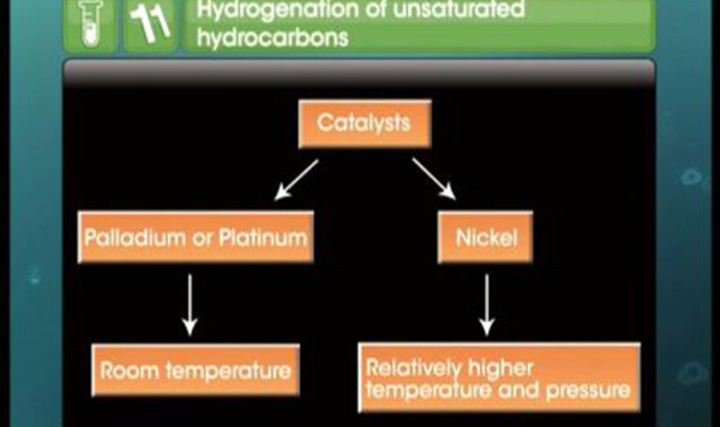 This video contains practice questions on IUPAC nomenclature, isomerism and preparation of alkanes.
This video contains practice questions on IUPAC nomenclature, isomerism and preparation of alkanes. -
Hydrocarbons
 This video explains physical properties of alkanes and substitution reactions of alkanes (halogenation).
This video explains physical properties of alkanes and substitution reactions of alkanes (halogenation). -
Hydrocarbons
 This video explains chemical reactions, such as combustion and pyrolysis, and conformations in alkanes.
This video explains chemical reactions, such as combustion and pyrolysis, and conformations in alkanes. -
Hydrocarbons
 This video contains practice questions on the properties and structures of alkanes.
This video contains practice questions on the properties and structures of alkanes. -
Hydrocarbons
 This video explains IUPAC nomenclature of alkynes.
This video explains IUPAC nomenclature of alkynes. -
Hydrocarbons
 This video explains the structure and acidic nature of alkynes and their methods of preparation from calcium carbide and vicinal dihalides.
This video explains the structure and acidic nature of alkynes and their methods of preparation from calcium carbide and vicinal dihalides. -
Hydrocarbons
 This video contains practice questions on nomenclature, structure, acidic nature and preparation of alkynes.
This video contains practice questions on nomenclature, structure, acidic nature and preparation of alkynes. -
Hydrocarbons
 This video explains the concept of aromatic hydrocarbons, aromaticity, IUPAC nomenclature and isomerism of aromatic hydrocarbons.
This video explains the concept of aromatic hydrocarbons, aromaticity, IUPAC nomenclature and isomerism of aromatic hydrocarbons. -
Hydrocarbons
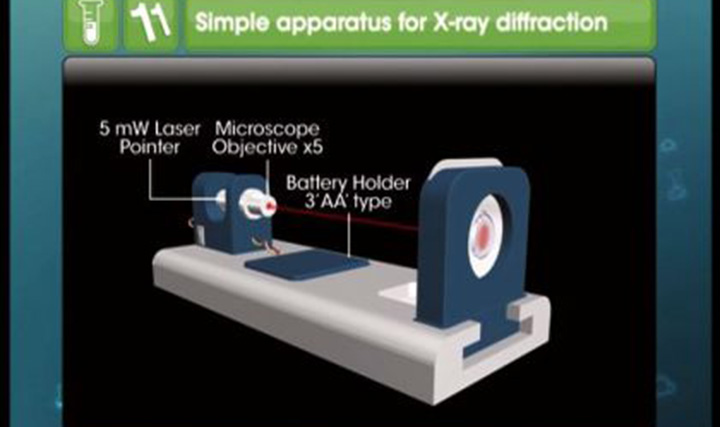 This video explains structure and resonance hybrid structure of benzene.
This video explains structure and resonance hybrid structure of benzene. -
Hydrocarbons
 This video contains practice questions on aromatic hydrocarbons.
This video contains practice questions on aromatic hydrocarbons. -
Addition of halogen to alkene
 This video explains addition of halogen to alkene
This video explains addition of halogen to alkene -
Addition of dihydrogen to alkene
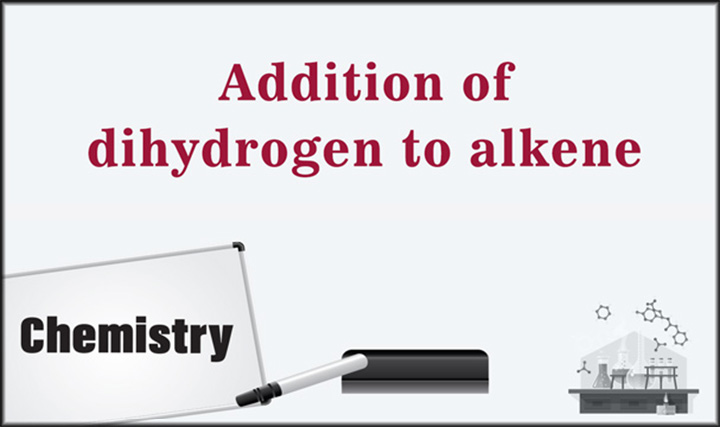 This video explains addition of dihydrogen to alkene.
This video explains addition of dihydrogen to alkene. -
Preparation of alkene from vicinal dihalide
 This video explains preparation of alkene from vicinal dihalide.
This video explains preparation of alkene from vicinal dihalide. -
Reaction mechanism of preparation of alkene from acidic dehydration of alcohols
 This video explains reaction mechanism of preparation of alkene from acidic dehydration of alcohols
This video explains reaction mechanism of preparation of alkene from acidic dehydration of alcohols -
Preparation of alkene from acidic dehydration of alcohols
 This video explains preparation of alkene from acidic dehydration of alcohols
This video explains preparation of alkene from acidic dehydration of alcohols -
Saytzeff rule
 This video explains the application of Saytzeff rule.
This video explains the application of Saytzeff rule. -
Preparation of alkene by partial reduction of alkynes
 This video explains preparation of alkene by partial reduction of alkynes.
This video explains preparation of alkene by partial reduction of alkynes. -
Preparation of alkene by dehydrohalogenation of alkyl halide
 This video explains preparation of alkene by dehydrohalogenation of alkyl halide
This video explains preparation of alkene by dehydrohalogenation of alkyl halide -
Cis and trans isomers of alkene
 This video disscuss about the cis and trans isomers of alkene.
This video disscuss about the cis and trans isomers of alkene. -
Different forms of Halo compounds
 This video explains about different forms of halo compounds, their nomenclature and Isomerism.
This video explains about different forms of halo compounds, their nomenclature and Isomerism. -
Characteristics of Halo Compounds
 This video explains the different forms of halo compounds, their nomenclature and isomerism
This video explains the different forms of halo compounds, their nomenclature and isomerism -
Characteristics of Halo Compounds
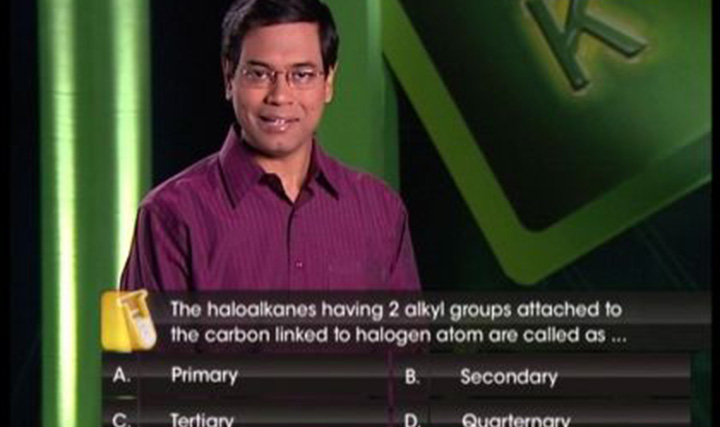 This video explains problems related to different forms of halo compounds, nomenclature and isomerism.
This video explains problems related to different forms of halo compounds, nomenclature and isomerism. -
Chemical Properties of Haloalakane and Haloarenes
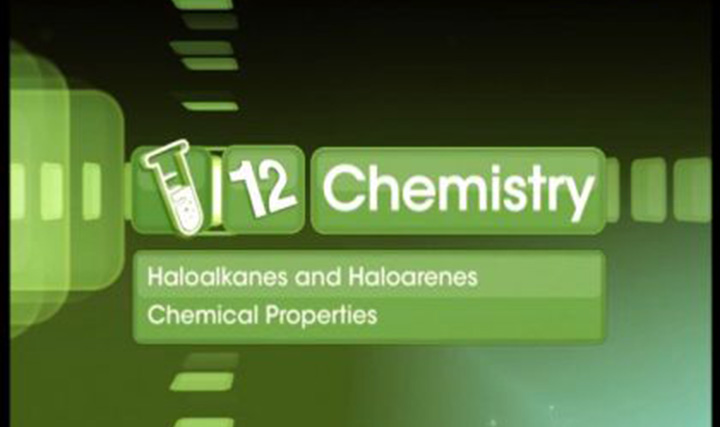 This video explains natureof C-X bond and its effect on Nucleophillic Substitution reaction, Elimination reaction.
This video explains natureof C-X bond and its effect on Nucleophillic Substitution reaction, Elimination reaction. -
Chemical Properties of Haloalakane and Haloarenes
 This video explains nature of C-X bond and its effect on nucleophilic substitution reaction, elimination reactions and reaction with metals.
This video explains nature of C-X bond and its effect on nucleophilic substitution reaction, elimination reactions and reaction with metals. -
Chemical Properties of Haloalkanes and Haloarenes with Exam Strategies
 In this video you will study the nature of the C-X bond and its effect on Nucleophilic substitution reaction. Elimination reactions and reactions with metals and various Exam Prep Strategies
In this video you will study the nature of the C-X bond and its effect on Nucleophilic substitution reaction. Elimination reactions and reactions with metals and various Exam Prep Strategies -
Preparation of Haloalkane and Haloarenes
 This video describes various methods of preparation of Haloalkane nad Haloarene.
This video describes various methods of preparation of Haloalkane nad Haloarene. -
Preparation of Haloalkane and Haloarenes
 This video contains various methods of preparation of Haloalkanes and Haloarenes.
This video contains various methods of preparation of Haloalkanes and Haloarenes. -
General Methods of Preparation
 This video explains various methods of preparation of Haloalkanes and Haloarenes
This video explains various methods of preparation of Haloalkanes and Haloarenes -
Polyhalogen Compounds
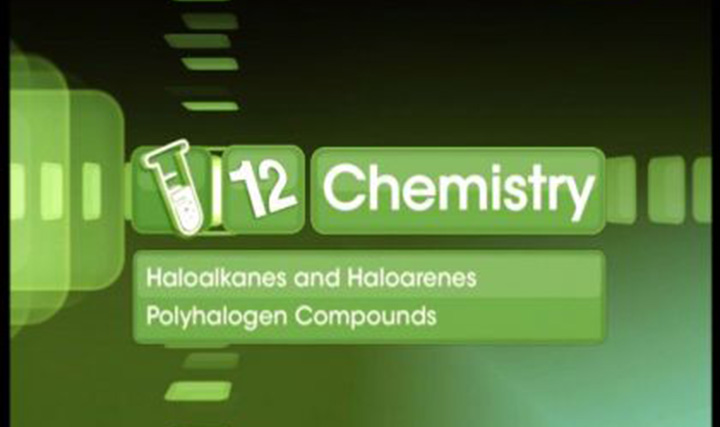 This video explains chemistry, preparation, properties anad uses of polyhalogen compounds like chloroform, iodoform freons and DDT.
This video explains chemistry, preparation, properties anad uses of polyhalogen compounds like chloroform, iodoform freons and DDT. -
Polyhalogen Compounds
 This video includes information related to preparation, properties and uses of polyhalogen compounds like chloroform, iodoform, freons and DDT
This video includes information related to preparation, properties and uses of polyhalogen compounds like chloroform, iodoform, freons and DDT -
Polyhalogen Compounds
 Chemistry, preparation, properties and uses of polyhalogen compounds like chloroform, iodoform freons, and DDT. Explanation of iodoform test.
Chemistry, preparation, properties and uses of polyhalogen compounds like chloroform, iodoform freons, and DDT. Explanation of iodoform test. -
Preparation of Amines

This Video explains about Classification of amines, Methods of preparation of amines, Physical properties of amines, uses of amines
-
Preparation of Amines
 This video explains various methods of preparation of Amines.
This video explains various methods of preparation of Amines. -
Preparation of Amines
 This video explains various methods of preparation of Amines.
This video explains various methods of preparation of Amines. -
Physical and chemical properties of amines
 Physical and chemical properties of amines
Physical and chemical properties of amines -
Physical and Chemical Properties of Amine
 This video is related to application of physical and chemical properties of Amine.
This video is related to application of physical and chemical properties of Amine. -
Properties of Amines
 Physical and chemical properties of amines
Physical and chemical properties of amines -
Classification of Amines
 This video explains the classification, structure and nomenclature of amines of aliphatic amine, aromatic amine.
This video explains the classification, structure and nomenclature of amines of aliphatic amine, aromatic amine. -
Physical and Chemical Properties of Amine
 This video explains classification, structure and nomenclature of amine.
This video explains classification, structure and nomenclature of amine. -
Study of Nitrogen Functional Group
 This video explains classification, structure and nomenclature of amine.
This video explains classification, structure and nomenclature of amine. -
Sandmeyer and Gatterman reaction
 This video explains the Sandmeyer and Gatterman reaction of diazonium salt.
This video explains the Sandmeyer and Gatterman reaction of diazonium salt. -
Preparation of diazonium salt and its mechanism
 This video explains the structural formula, nomenclature, preparation and its reaction mechanism of diazonium salt.
This video explains the structural formula, nomenclature, preparation and its reaction mechanism of diazonium salt. -
Introduction of Diazonium salts
 This video explains the structural formula and nomenclature of Diazonium salt.
This video explains the structural formula and nomenclature of Diazonium salt. -
Coupling reactions
 This video explains the Coupling reactions of diazonium salt.
This video explains the Coupling reactions of diazonium salt. -
Characteristics of Phenols
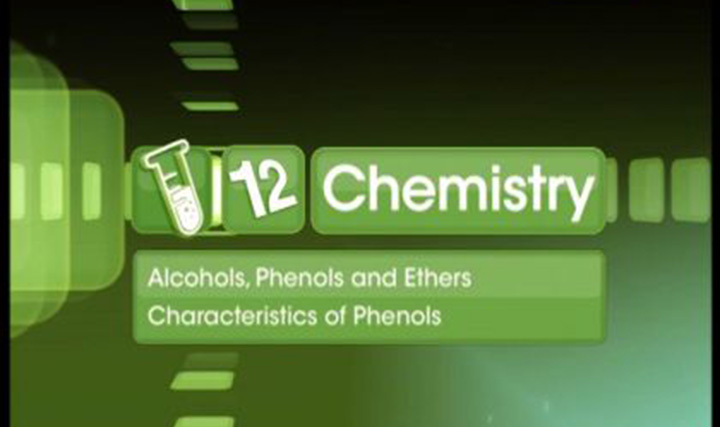 This video explains the acidic nature of phenol, elctrophilic aromatic substitution reactions and uses of phenol.
This video explains the acidic nature of phenol, elctrophilic aromatic substitution reactions and uses of phenol. -
Phenol
 This video explains acidic nature of phenol, electrophilic aromatic substitution reaction and uses of phenol.
This video explains acidic nature of phenol, electrophilic aromatic substitution reaction and uses of phenol. -
Characteristic of Phenols
 Study acidic nature of phenol, elctrophilic aromatic substitution reactions and uses of phenol.
Study acidic nature of phenol, elctrophilic aromatic substitution reactions and uses of phenol. -
Preparation of Ethers
 This video explains the preparation and properties of Ethers.
This video explains the preparation and properties of Ethers. -
Preparation and Properties of Ether
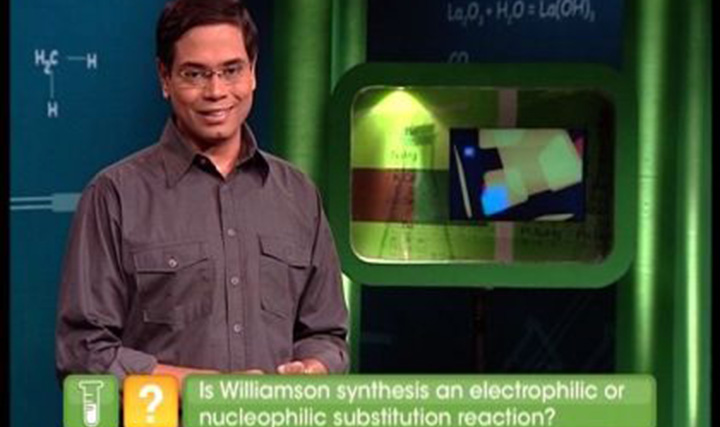 This video explains preparation methods and properties of Ether.
This video explains preparation methods and properties of Ether. -
Ethers : Preparation and properties
 Ethers : Preparation and properties
Ethers : Preparation and properties -
Preparation of Alcohols and Phenols
 This video explains methods of preparation of primary, secondary and tertiary alcohol.
This video explains methods of preparation of primary, secondary and tertiary alcohol. -
Preparation of Phenols
 This video explains Phenols, its preparation.
This video explains Phenols, its preparation. -
Preparation of Alcohols and Phenols
 Methods of preparation of alcohols, using Grignard's reagent to prepare primary, secondary and tertiary alcohols. Methods of preparation of phenols
Methods of preparation of alcohols, using Grignard's reagent to prepare primary, secondary and tertiary alcohols. Methods of preparation of phenols -
Properties of Alcohols
 This video explains physical and chemical properties, its reactions and Lucas test to distinguish between primary, secondary and tertiary alcohols
This video explains physical and chemical properties, its reactions and Lucas test to distinguish between primary, secondary and tertiary alcohols -
Properties of Alcohols
 This video explains physical and chemical properties of alcohols, its reaction and Lucas Test to distinguish between primary, secondary and tertiary alcohol.
This video explains physical and chemical properties of alcohols, its reaction and Lucas Test to distinguish between primary, secondary and tertiary alcohol. -
Properties of Alcohols
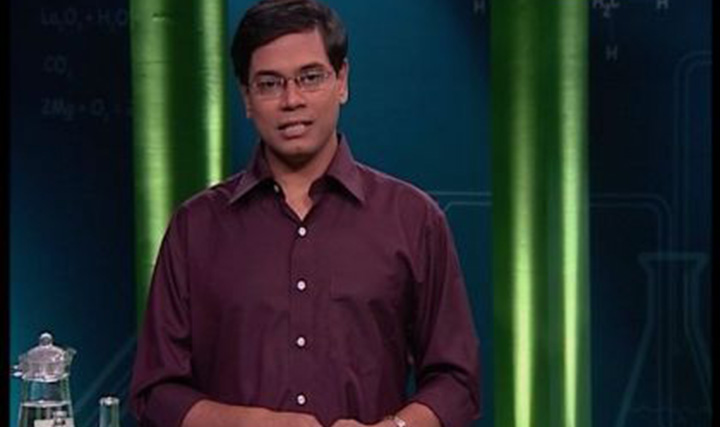 Physical and chemical properties of alcohols, its reactions and Lucas test to distinguish between primary, secondary and tertiary alcohols.
Physical and chemical properties of alcohols, its reactions and Lucas test to distinguish between primary, secondary and tertiary alcohols. -
Methods of preparation of Aldehydes and Ketones.
 This video explains the Methods of preparation, Important reactions of Aldehydes and Ketones.
This video explains the Methods of preparation, Important reactions of Aldehydes and Ketones. -
Concepts on aldehydes and ketones
 This video explains the Methods of preparation, Important reactions of Aldehydes and Ketones.
This video explains the Methods of preparation, Important reactions of Aldehydes and Ketones. -
Aldehydes and Ketones: Exam Prep Strategies
 This video explains the Methods of preparation, Important reactions of Aldehydes and Ketones.
This video explains the Methods of preparation, Important reactions of Aldehydes and Ketones. -
General study of compounds containing carbonyl group
 Study the general features of carbonyl group, naming of aldehydes and ketones. Nomenclature of carboxylic acids.
Study the general features of carbonyl group, naming of aldehydes and ketones. Nomenclature of carboxylic acids. -
General study of Carbonyl group
 Study the general features of carbonyl group, naming of aldehydes and ketones. Nomenclature of carboxylic acids.
Study the general features of carbonyl group, naming of aldehydes and ketones. Nomenclature of carboxylic acids. -
General Study of Carbonyl Compounds: Exam Prep Strategies
 Study the general features of carbonyl group, naming of aldehydes and ketones. Nomenclature of carboxylic acids.
Study the general features of carbonyl group, naming of aldehydes and ketones. Nomenclature of carboxylic acids. -
Carboxylic acids
 This video gives an overview of carboxylic acid and discuss about its chemical structure with its resonating structures
This video gives an overview of carboxylic acid and discuss about its chemical structure with its resonating structures -
Hell-Volhard-Zelinsky reaction
 This video explains substitution reactions in hydrocarbon parts. This reaction is known as Hell-Volhard-Zelinsky reaction.
This video explains substitution reactions in hydrocarbon parts. This reaction is known as Hell-Volhard-Zelinsky reaction. -
Chemical reactions of carboxylic acids with ammonia
 This video explains the Chemical reactions of carboxylic acids with ammonia
This video explains the Chemical reactions of carboxylic acids with ammonia -
Chemical reactions of carboxylic acids with PCl5 PCl3 SOCl2
 This video explains the Chemical reactions of carboxylic acids with PCl5 PCl3 SOCl2
This video explains the Chemical reactions of carboxylic acids with PCl5 PCl3 SOCl2 -
Chemical reactions of carboxylic acids decarboxylation
 This video explains a chemical reaction of carboxylic acids which is decarboxylation.
This video explains a chemical reaction of carboxylic acids which is decarboxylation. -
Chemical reactions of carboxylic acids Reduction
 This video explains the reduction reactions of carboxylic acids and reducing agents.
This video explains the reduction reactions of carboxylic acids and reducing agents. -
Chemical reactions of carboxylic acids Esterification
 This video explains a chemical reaction of carboxylic acids which is esterification
This video explains a chemical reaction of carboxylic acids which is esterification -
Chemical reactions of carboxylic acids formation of anhydride
 This video explains the chemical reactions of carboxylic acids in which anhydride form as a product.
This video explains the chemical reactions of carboxylic acids in which anhydride form as a product. -
Chemical reactions of carboxylic acids with metal
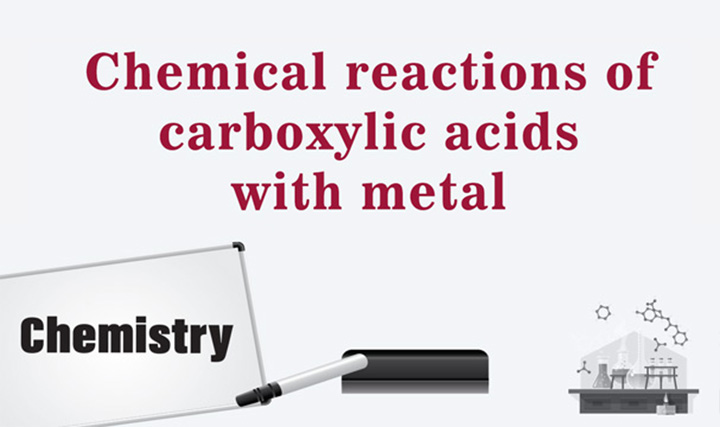 This video explains the chemical reactions of carboxylic acids with metal
This video explains the chemical reactions of carboxylic acids with metal -
Preparation of carboxylic acids from esters
 This video explains a method of preparation of carboxylic acids from esters
This video explains a method of preparation of carboxylic acids from esters -
Preparation of carboxylic acids from acyl halides and anhydrides
 This video explains a method of preparation of carboxylic acids from acyl halides and anhydrides
This video explains a method of preparation of carboxylic acids from acyl halides and anhydrides -
Preparation of carboxylic acids from Grignard reagents
 This video explains a method of preparation of carboxylic acids from Grignard reagents
This video explains a method of preparation of carboxylic acids from Grignard reagents -
Preparation of carboxylic acids from nitriles and amides
 This video explains a method of preparation of carboxylic acids from nitriles and amides
This video explains a method of preparation of carboxylic acids from nitriles and amides -
Preparation of carboxylic acids from alkyl benzenes
 This video explains a method of preparation of carboxylic acids from alkyl benzenes
This video explains a method of preparation of carboxylic acids from alkyl benzenes -
Preparation of carboxylic acids by oxidation of alcohols and aldehydes
 This video explains a method of preparation of carboxylic acid by oxidation of alcohols and aldehydes.
This video explains a method of preparation of carboxylic acid by oxidation of alcohols and aldehydes. -
Nomenclature of carboxylic acids
 This video explains the IUPAC Nomenclature of carboxylic acid
This video explains the IUPAC Nomenclature of carboxylic acid -
Nomenclautre of ehers
 This video explains common name and IUPAC nomenclautre of ehers with examples
This video explains common name and IUPAC nomenclautre of ehers with examples -
Nomenclautre of phenols
 This video explains the common name and IUPAC Nomenclature of phenols with examples
This video explains the common name and IUPAC Nomenclature of phenols with examples -
Nomenclautre of alcohols
 This video explains common name and IUPAC Nomenclature of alcohols with examples
This video explains common name and IUPAC Nomenclature of alcohols with examples -
Ethers
 This video gives an overview of ethers and discuss their nomenclature
This video gives an overview of ethers and discuss their nomenclature -
Redox Reactions
 This video explains oxidation, reduction in terms of classical view and in terms of electron loss or gain.
This video explains oxidation, reduction in terms of classical view and in terms of electron loss or gain. -
Redox Reactions
 This video explains oxidation and reduction in terms of electron transfer reactions, oxidising agents and reducing agents.
This video explains oxidation and reduction in terms of electron transfer reactions, oxidising agents and reducing agents. -
Redox Reactions
 This video contains practice questions on redox reactions.
This video contains practice questions on redox reactions. -
Redox Reactions
 This video explains competitive electron transfer reactions, oxidation number and rules for the calculation of oxidation numbers.
This video explains competitive electron transfer reactions, oxidation number and rules for the calculation of oxidation numbers. -
Redox Reactions
 This video explains the rules for the calculation of oxidation number, the stock notation method and examples of redox reactions.
This video explains the rules for the calculation of oxidation number, the stock notation method and examples of redox reactions. -
Redox Reactions
 This video contains practice questions on oxidation number.
This video contains practice questions on oxidation number. -
Redox Reactions
 This video explains the oxidation number method for balancing redox reactions.
This video explains the oxidation number method for balancing redox reactions. -
Redox Reactions
 This video explains the half reaction method and the half reaction method to balance redox reactions in acidic and basic media.
This video explains the half reaction method and the half reaction method to balance redox reactions in acidic and basic media. -
Redox Reactions
 This video contains practice questions based on balancing redox reactions.
This video contains practice questions based on balancing redox reactions. -
Redox Reactions
 This video explains direct and indirect redox reactions, and the construction of an electrochemical cell.
This video explains direct and indirect redox reactions, and the construction of an electrochemical cell. -
Standard Electrode Potential - Part 1
 This video explains the construction of electrochemical cell, the concept of electrode potential and the calculation of cell potential by using electrode potential.
This video explains the construction of electrochemical cell, the concept of electrode potential and the calculation of cell potential by using electrode potential. -
Redox Reactions
 This video explains the meaning of electrode potential, standard electrode potential and calculation of emf of an electrochemical cell by using electrode potential.
This video explains the meaning of electrode potential, standard electrode potential and calculation of emf of an electrochemical cell by using electrode potential. -
Redox Reactions
 This video contains practice questions based on electrode potential.
This video contains practice questions based on electrode potential. -
Electrolytic Conductance
 This video explains about conductivity and resistance.
This video explains about conductivity and resistance. -
Concepts on conductivity of solutions
 This video explains the Conductivity of Solutions.
This video explains the Conductivity of Solutions. -
Conductivity of Solutions
 This video explains about problems related to conductivity of solutions.
This video explains about problems related to conductivity of solutions. -
Kohlrausch's Law
 This video explains comparison and calculation of conductivities of strong and weak electrolytes, Kholrausch's law and its application.
This video explains comparison and calculation of conductivities of strong and weak electrolytes, Kholrausch's law and its application. -
Compare and calculate the conductivities of strong and weak electrolytes
 Compare and calculate the conductivities of strong and weak electrolytes. Kohlrausch's Law and its application.
Compare and calculate the conductivities of strong and weak electrolytes. Kohlrausch's Law and its application. -
Kohlrausch's Law
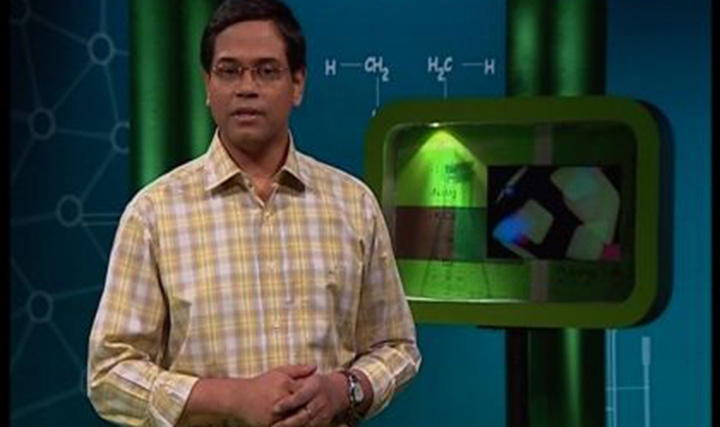 Compare and calculate the conductivities of strong and weak electrolytes, Kohlrausch's Law and its application.
Compare and calculate the conductivities of strong and weak electrolytes, Kohlrausch's Law and its application. -
Concept of electrolysis and Faraday's laws of electrolysis
 Understand the concept of electrolysis and Faraday's laws of electrolysis, construction & working of electrolytic cells. Numericals on Faraday's law.
Understand the concept of electrolysis and Faraday's laws of electrolysis, construction & working of electrolytic cells. Numericals on Faraday's law. -
Electrolysis
 This video explains the concept of electrolysis, Faraday's law of electrolysis, construction and working electrolytic cell. It also contains numericals on Feraday's law.
This video explains the concept of electrolysis, Faraday's law of electrolysis, construction and working electrolytic cell. It also contains numericals on Feraday's law. -
Concept of electrolysis and Faraday's laws of electrolysis
 Understand the concept of electrolysis and Faraday's laws of electrolysis, construction & working of electrolytic cells. Numericals on Faraday's law.
Understand the concept of electrolysis and Faraday's laws of electrolysis, construction & working of electrolytic cells. Numericals on Faraday's law. -
Electrochemical Cells
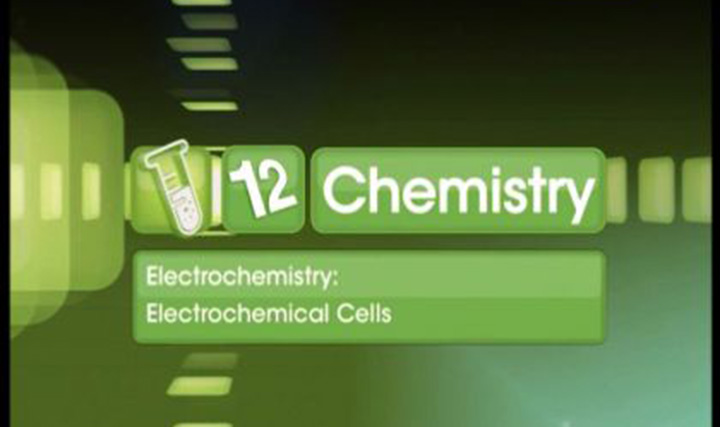 This video explains the meaning of Redox reaction, construction and working of Galvanic cells and salt bridge
This video explains the meaning of Redox reaction, construction and working of Galvanic cells and salt bridge -
Redox Reactions and Galvanic Cells
 This video explains meaning of Redox reaction, construction and working of Galvanic cell and Salt Bridge.
This video explains meaning of Redox reaction, construction and working of Galvanic cell and Salt Bridge. -
Electrochemical Cells
 This video involves problems related to redox reaction, Galvanic cell and salt bridge
This video involves problems related to redox reaction, Galvanic cell and salt bridge -
Electrode potential and standard electrode potential
 Learn the definition of cell potential and EMF of a cell & standard electrode potential. Discuss the construction of electro chemicals series and is application.
Learn the definition of cell potential and EMF of a cell & standard electrode potential. Discuss the construction of electro chemicals series and is application. -
Standard Electrode Potential - Part 2
 This video explains the construction of standard hydrogen electrode, reference electrodes and building the electrochemical series.
This video explains the construction of standard hydrogen electrode, reference electrodes and building the electrochemical series. -
Nernst Equation
 This video explains about Nernst equation, Cell potential, relation between Gibb's energy and equilibrium constant.
This video explains about Nernst equation, Cell potential, relation between Gibb's energy and equilibrium constant. -
Nernst Equation
 This video explains Nernst equation, Cell Potential, Equilibrium Constant, Gibb's Energy
This video explains Nernst equation, Cell Potential, Equilibrium Constant, Gibb's Energy -
Nernst Equation
 This video explains Nernst equation, Cell Potential, Equilibrium Constant, Gibb's Energy
This video explains Nernst equation, Cell Potential, Equilibrium Constant, Gibb's Energy -
About Primary and secondary cells
 Classification of cell as primary & secondary. Construction working & application of Dry, Mercury, Fuel, Lead storage and Nickel cadmium cell.
Classification of cell as primary & secondary. Construction working & application of Dry, Mercury, Fuel, Lead storage and Nickel cadmium cell. -
Batteries
 This video explains classification of cell as primary and secondary, construction, working and application of dry, mercury, fuel, lead storage and Nickel cadmium cell
This video explains classification of cell as primary and secondary, construction, working and application of dry, mercury, fuel, lead storage and Nickel cadmium cell -
Standard Hydrogen Electrode
 This video explains classification of cell, construction, working and application of Dry, Mercury, Fuel, Lead storage and Nickel Cadmium cell
This video explains classification of cell, construction, working and application of Dry, Mercury, Fuel, Lead storage and Nickel Cadmium cell -
Corrosion and Rusting of Iron
 This video explains the meaning of Corrosion, electrochemical process, factors, Prevention of corrosion, rusating of iron.
This video explains the meaning of Corrosion, electrochemical process, factors, Prevention of corrosion, rusating of iron. -
Concepts related to corrosion
 Understand the meaning of corrosion. Electrochemical process, factors, prevention of corrosion, rusting of iron.
Understand the meaning of corrosion. Electrochemical process, factors, prevention of corrosion, rusting of iron. -
Corrosion
 This video explains problems related to corrosion, electrochemical process, factors, prevention of corrosion, rusting of iron.
This video explains problems related to corrosion, electrochemical process, factors, prevention of corrosion, rusting of iron. -
The s-Block Elements
 This video introduces s-block elements and explains the electronic configuration, trends in atomic and ionic sizes and ionisation enthalpy of Group 1 elements of the s-block.
This video introduces s-block elements and explains the electronic configuration, trends in atomic and ionic sizes and ionisation enthalpy of Group 1 elements of the s-block. -
The s-Block Elements
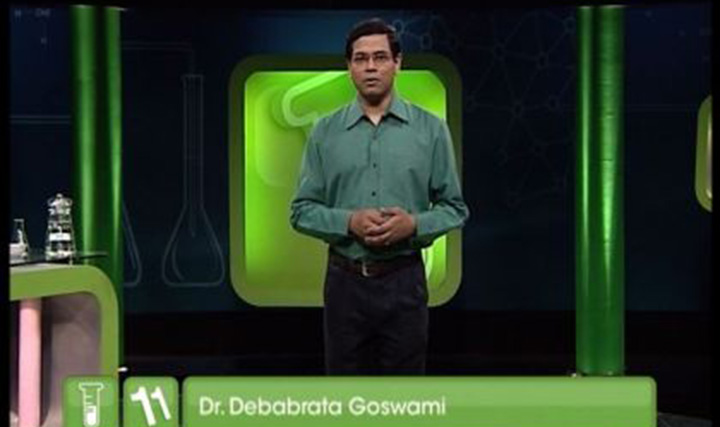 This video explains hydration enthalpy, physical and chemical properties of Group 1 elements of the s-block.
This video explains hydration enthalpy, physical and chemical properties of Group 1 elements of the s-block. -
The s-Block Elements
 This video contains practice questions on Group 1 elements of the s-block.
This video contains practice questions on Group 1 elements of the s-block. -
The s-Block Elements
 This video gives a general introduction to Group 2 elements, explains the electronic configuration, atomic radii, ionic radii and hydration enthalpy of Group 2 elements of the s-block.
This video gives a general introduction to Group 2 elements, explains the electronic configuration, atomic radii, ionic radii and hydration enthalpy of Group 2 elements of the s-block. -
The s-Block Elements
 This video explains ionisation enthalpy and physical properties of Group 2 elements of the s-block.
This video explains ionisation enthalpy and physical properties of Group 2 elements of the s-block. -
The s-Block Elements
 This video contains practice questions on Group 2 elements of the s-block.
This video contains practice questions on Group 2 elements of the s-block. -
The s-Block Elements
 This video explains anomalous behaviour of lithium and beryllium.
This video explains anomalous behaviour of lithium and beryllium. -
The s-Block Elements
 This video explains the diagonal relationship between lithium and magnesium, diagonal relationship between beryllium and aluminium, and variation in the properties of Group 1 and Group 2 elements.
This video explains the diagonal relationship between lithium and magnesium, diagonal relationship between beryllium and aluminium, and variation in the properties of Group 1 and Group 2 elements. -
The s-Block Elements
 This video contains practice questions on the anomalous behaviour of lithium and beryllium, their diagonal relationships with magnesium and aluminium, respectively, and variations in Group 1 and Group 2 elements.
This video contains practice questions on the anomalous behaviour of lithium and beryllium, their diagonal relationships with magnesium and aluminium, respectively, and variations in Group 1 and Group 2 elements. -
The s-Block Elements
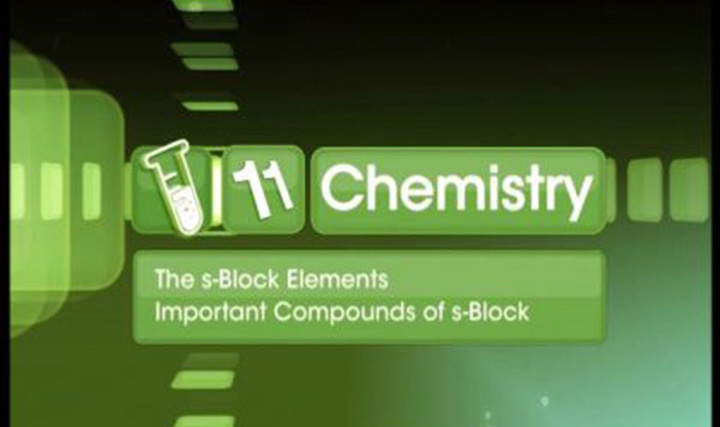 This video explains the preparation and uses of sodium carbonate and sodium hydrogen carbonate.
This video explains the preparation and uses of sodium carbonate and sodium hydrogen carbonate. -
The s-Block Elements
 This video explains the preparation and uses of sodium hydroxide, calcium oxide, calcium hydroxide and calcium carbonate.
This video explains the preparation and uses of sodium hydroxide, calcium oxide, calcium hydroxide and calcium carbonate. -
The s-Block Elements
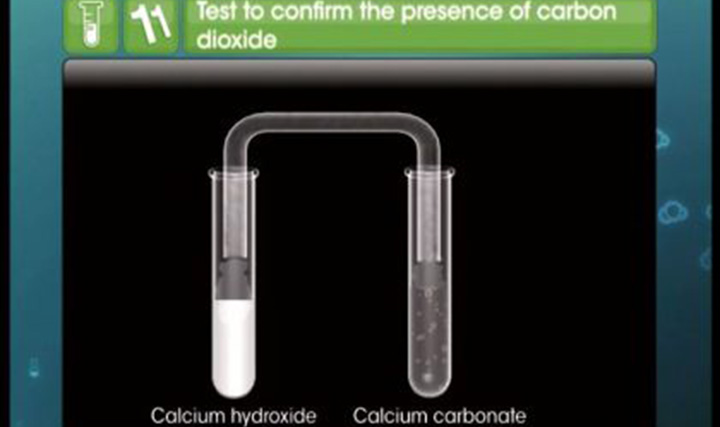 This video contains practice questions on compounds of sodium and calcium.
This video contains practice questions on compounds of sodium and calcium. -
The s-Block Elements
 This video explains then comparison between oxides and hydroxides of alkali metals and alkaline earth metals.
This video explains then comparison between oxides and hydroxides of alkali metals and alkaline earth metals. -
The s-Block Elements
 This video explains the comparison between halides, sulphates, carbonates and nitrates of alkali metals and alkaline earth metals.
This video explains the comparison between halides, sulphates, carbonates and nitrates of alkali metals and alkaline earth metals. -
The s-Block Elements
 This video contains practice questions on general characteristics of compounds of Group 1 and Group 2 elements.
This video contains practice questions on general characteristics of compounds of Group 1 and Group 2 elements. -
Association and dissociation of compounds
 Discuss the meaning of abnormal molecular masses due to association & dissociation of compounds. Van't Hoff factor, numericals on colligative property.
Discuss the meaning of abnormal molecular masses due to association & dissociation of compounds. Van't Hoff factor, numericals on colligative property. -
Abnormal molecular masses due to association and dissociation of compounds
 Discuss the meaning of abnormal molecular masses due to association & dissociation of compounds. Vant Hoff factor, numericals on colligative property.
Discuss the meaning of abnormal molecular masses due to association & dissociation of compounds. Vant Hoff factor, numericals on colligative property. -
Association and dissociation

Discuss the meaning of abnormal molecular masses due to association & dissociation of compounds, Van't Hoff factor and numericals on colligative property.
-
Concepts on Boiling and Freezing points of solution
 Learn the meaning of elevation in boiling point & depression in freezing point of solution, numerical on the same & molecular weight of compounds.
Learn the meaning of elevation in boiling point & depression in freezing point of solution, numerical on the same & molecular weight of compounds. -
Boiling and Freezing Point
 This video explains about elevation in boiling point, depression in freezing point, molecular weight of compounds.
This video explains about elevation in boiling point, depression in freezing point, molecular weight of compounds. -
Boiling and Freezing pt. of Soln.
 Learn the meaning of elevation in boiling point & depression in freezing point of solution, numerical on the same & molecular weight of compounds.
Learn the meaning of elevation in boiling point & depression in freezing point of solution, numerical on the same & molecular weight of compounds. -
Ideal Solutions
 This video explains concept of colligative properties and vapour pressure, Raoults law, Ideal and Non-Ideal solutions, numerical on relative lowering of vapour pressure
This video explains concept of colligative properties and vapour pressure, Raoults law, Ideal and Non-Ideal solutions, numerical on relative lowering of vapour pressure -
Concept of colligative properties
 Concept of colligative properties & vapour pressure (vp), Raoults law, ideal/non ideal solutions, numerical on relative lowering of vapour pressure.
Concept of colligative properties & vapour pressure (vp), Raoults law, ideal/non ideal solutions, numerical on relative lowering of vapour pressure. -
Solutions and Ideal Solutions
 This video focuses on the concepts of colligative properties & vapour pressure (vp), Raoults law, ideal/non ideal solutions, numerical on relative lowering of vapour pressure.
This video focuses on the concepts of colligative properties & vapour pressure (vp), Raoults law, ideal/non ideal solutions, numerical on relative lowering of vapour pressure. -
Osmosis and Osmotic Pressure
 This video explains osmosis, reverse osmosis, osmotic pressure, relating osmotic pressure as colligative property.
This video explains osmosis, reverse osmosis, osmotic pressure, relating osmotic pressure as colligative property. -
About Osmosis and osmotic pressure
 Understand osmosis & reverse osmosis, osmotic pressure. Relate osmotic pressure as colligative property.
Understand osmosis & reverse osmosis, osmotic pressure. Relate osmotic pressure as colligative property. -
Osmosis
 This video contains information related to osmosis and reverse osmosis.
This video contains information related to osmosis and reverse osmosis. -
Expressing concentration of solutions
 Learn the types of solution, ways of expressing the concentration of solutions - morality, mass percentage, molality, mol fraction & normality.
Learn the types of solution, ways of expressing the concentration of solutions - morality, mass percentage, molality, mol fraction & normality. -
Types and concentration of solutions
 Learn the types of solution, ways of expressing the concentration of solutions - molarity, mass percentage, molality, mol fraction & normality.
Learn the types of solution, ways of expressing the concentration of solutions - molarity, mass percentage, molality, mol fraction & normality. -
Strength of Solutions
 This video includes problems related to types of solution and concentrations.
This video includes problems related to types of solution and concentrations. -
Types of Solution
 This video explains about characteristics of solution, solute and solvent and their types with examples. It gives a basic idea about physical states of solution.
This video explains about characteristics of solution, solute and solvent and their types with examples. It gives a basic idea about physical states of solution. -
Basic Concepts of Chemistry
 This video explains the importance of chemistry in daily life, SI units of basic physical quantities and the prefixes used in the SI unit system.
This video explains the importance of chemistry in daily life, SI units of basic physical quantities and the prefixes used in the SI unit system. -
Basic Concepts of Chemistry
 This video explains the concept of precision, accuracy and significant figures.
This video explains the concept of precision, accuracy and significant figures. -
Basic Concepts of Chemistry
 This video contains practice questions on importance of chemistry in daily life, SI units, precision, accuracy and significant figures.
This video contains practice questions on importance of chemistry in daily life, SI units, precision, accuracy and significant figures. -
Basic Concepts of Chemistry
 This video explains the law of conservation of mass, law of definite proportions and the law of multiple proportions.
This video explains the law of conservation of mass, law of definite proportions and the law of multiple proportions. -
Basic Concepts of Chemistry
 This video explains the law of multiple proportions, Gay-Lussac's law of gaseous volume and Avogadro law.
This video explains the law of multiple proportions, Gay-Lussac's law of gaseous volume and Avogadro law. -
Basic Concepts of Chemistry
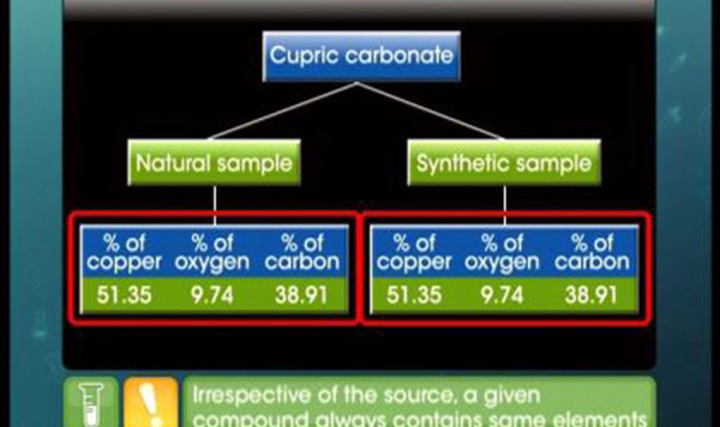 This video contains practice questions on the laws of chemical combination.
This video contains practice questions on the laws of chemical combination. -
Basic Concepts of Chemistry
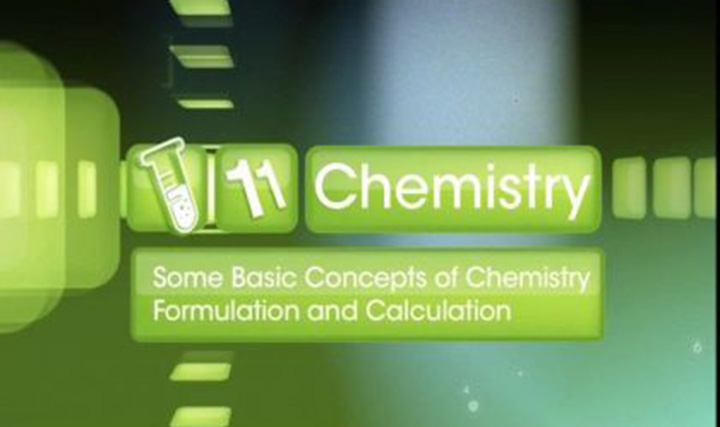 This video explains the concept percentage composition and empirical formula.
This video explains the concept percentage composition and empirical formula. -
Basic Concepts of Chemistry
 This video explains the calculation of empirical formula, molecular formula and numerical problems.
This video explains the calculation of empirical formula, molecular formula and numerical problems. -
Basic Concepts of Chemistry
 This video contains practice questions and numerical problems based on the percentage composition and empirical formula.
This video contains practice questions and numerical problems based on the percentage composition and empirical formula. -
Mole Concept
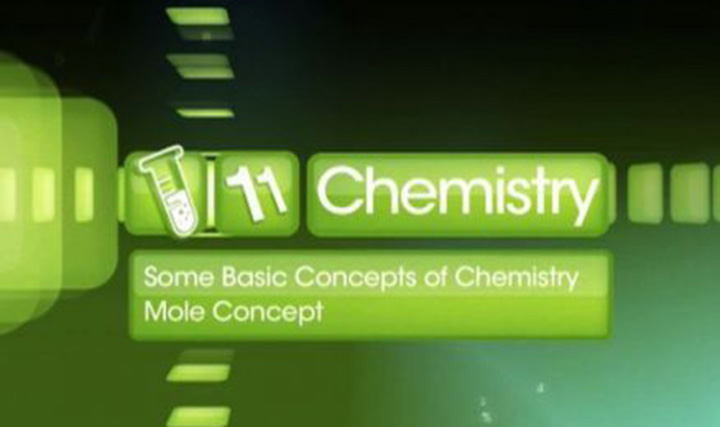
Recall & understand Mole concept done in class IX. Calculation of mass percentage, mole fraction, molarity and Molality.
-
Molarity and Molality

Recall & understand Mole concept done in class IX. Calculation of mass percentage, mole fraction, molarity and Molality.
-
Basic Concepts of Chemistry
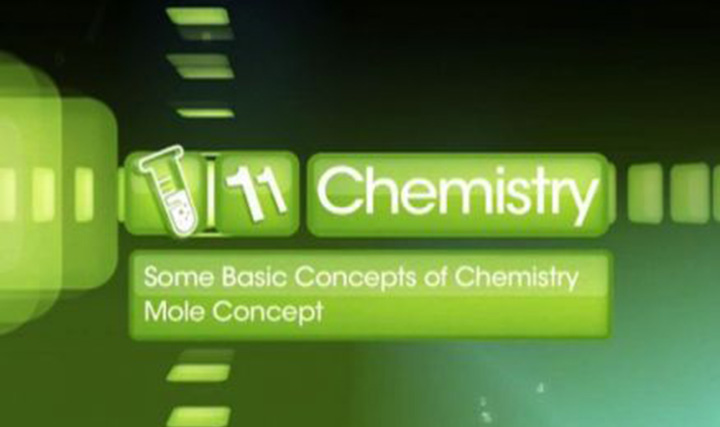 This video contains practice questions and numerical problems based on the mole concept.
This video contains practice questions and numerical problems based on the mole concept. -
Basic Concepts of Chemistry
 This video explains classification and physical properties of matter.
This video explains classification and physical properties of matter. -
Basic Concepts of Chemistry
 This video explains the concepts of atomic mass, molecular mass, formula mass, molar mass and stoichiometry and limiting reagents.
This video explains the concepts of atomic mass, molecular mass, formula mass, molar mass and stoichiometry and limiting reagents. -
Basic Concepts of Chemistry
 This video contains practice questions based on the classification of matter, mass and stoichiometry.
This video contains practice questions based on the classification of matter, mass and stoichiometry. -
Moles

This video explains about Mole.It also includes relation between number of moles, Molecular or Atomic mass, number of particles, Volume of gas at STP.
-
Molarity

This video includes definition and formulae of Molarity, which is applied in numericals
-
Limiting Reagent

This is a problem-solving video which explains an approach to solving numerically related to Limiting reagent.
-
% Concentration, PPM and PPB

This video includes information related to various concentration terms Parts per Million, Parts per Billion and % weight by weight, % weight by volume, % volume by volume.
-
Empirical Formula
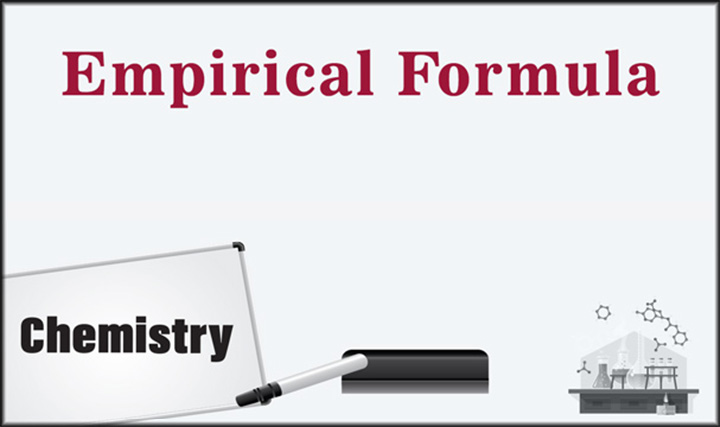
This video is a problem-solving video which explains an approach to find out empirical formulae in problems
-
Basic Concepts of Titration

This video explains the basic concept of titration. This concept helps in determining equivalence point and role of indicator in titration.
-
Relation in Density, Molarity and Molality

This is a problem-solving video which explains an approach to solve problems related to density, molarity and molality.
-
Molarity of Mixtures

This video explains the method to find out molarity when different solutions are mixed.
-
Normality

This video includes definition and formulae of Normality, which is applied in numerical. It also explains the equivalent weight and valency factor.
-
Basic Principles of Organic Chemistry
 This video explains the properties of carbon, classification of organic compounds and IUPAC nomenclature of straight and branched chain alkanes.
This video explains the properties of carbon, classification of organic compounds and IUPAC nomenclature of straight and branched chain alkanes. -
Basic Principles of Organic Chemistry
 This video explains the rules of IUPAC nomenclature for naming branched chain alkanes.
This video explains the rules of IUPAC nomenclature for naming branched chain alkanes. -
Basic Principles of Organic Chemistry
 This video contains practice questions on the classification of organic compounds and IUPAC nomenclature of alkanes.
This video contains practice questions on the classification of organic compounds and IUPAC nomenclature of alkanes. -
Basic Principles of Organic Chemistry
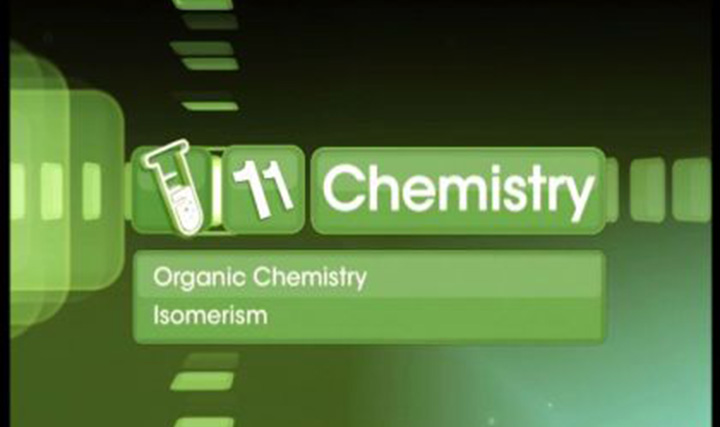 This video explains structural isomerism.
This video explains structural isomerism. -
Basic Principles of Organic Chemistry
 This video explains stereoisomerism.
This video explains stereoisomerism. -
Basic Principles of Organic Chemistry
 This video contains practice questions on isomerism and its types.
This video contains practice questions on isomerism and its types. -
Basic Principles of Organic Chemistry
 This video explains reaction mechanism and homolytic cleavage.
This video explains reaction mechanism and homolytic cleavage. -
Basic Principles of Organic Chemistry
 This video explains heterolytic cleavage and reaction intermediates such as free radical, carbocations and carbanions.
This video explains heterolytic cleavage and reaction intermediates such as free radical, carbocations and carbanions. -
Basic Principles of Organic Chemistry
 This video contains practice questions on homolytic and heterolytic cleavage of reaction mechanism.
This video contains practice questions on homolytic and heterolytic cleavage of reaction mechanism. -
Basic Principles of Organic Chemistry
 This video explains nucleophiles, electrophiles and the substitution reaction.
This video explains nucleophiles, electrophiles and the substitution reaction. -
Basic Principles of Organic Chemistry
 This video explains addition reactions, elimination reactions and rearrangement reactions.
This video explains addition reactions, elimination reactions and rearrangement reactions. -
Basic Principles of Organic Chemistry
 This video contains practice questions on types of organic reactions.
This video contains practice questions on types of organic reactions. -
States of Matter
 This video explains dipole, dipole moment and a type of van der Waals force - dipole-dipole force.
This video explains dipole, dipole moment and a type of van der Waals force - dipole-dipole force. -
States of Matter
 This video explains the types of van der Waals forces - dipole-induced dipole forces and dispersion forces or London forces and repulsive forces.
This video explains the types of van der Waals forces - dipole-induced dipole forces and dispersion forces or London forces and repulsive forces. -
States of Matter
 This video contains practice questions on van der Waals intermolecular forces.
This video contains practice questions on van der Waals intermolecular forces. -
States of Matter
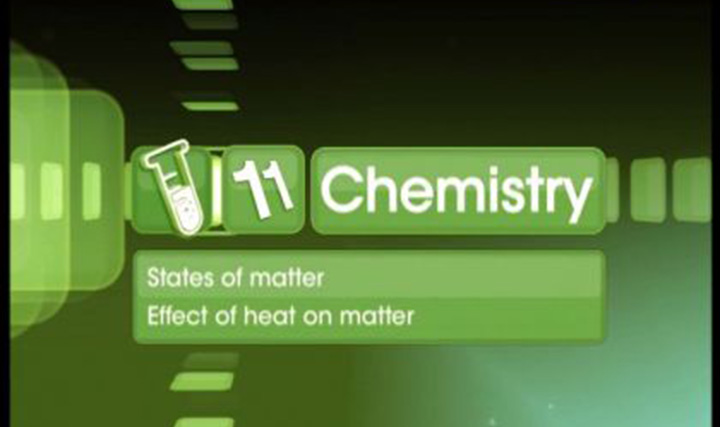 This video explains the relationship between thermal energy and intermolecular forces in solid, liquids and gases.
This video explains the relationship between thermal energy and intermolecular forces in solid, liquids and gases. -
Effect of Heat on Matter: Exam Prep Strategies
 Interaction between thermal energy and inter molecular forces on the three states of matter affecting properties like melting and boiling point etc.
Interaction between thermal energy and inter molecular forces on the three states of matter affecting properties like melting and boiling point etc. -
Gas Laws - Part 1
 This video explains the physical properties of gases, Boyle's law and Charles’s law.
This video explains the physical properties of gases, Boyle's law and Charles’s law. -
States of Matter
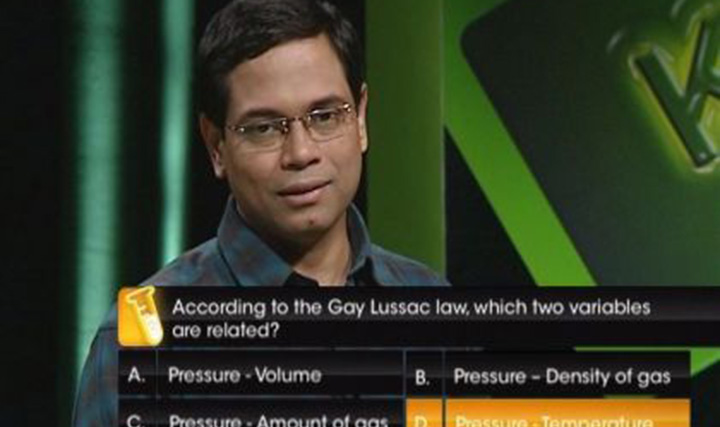 This video explains Gay-Lussac's law, Avogadro law and Dalton's law.
This video explains Gay-Lussac's law, Avogadro law and Dalton's law. -
States of Matter
 This video contains practice questions and numerical problems based on gas laws.
This video contains practice questions and numerical problems based on gas laws. -
States of Matter
 This video contains practice questions on three states of matter.
This video contains practice questions on three states of matter. -
States of Matter
 This video explains the ideal behaviour of gases.
This video explains the ideal behaviour of gases. -
States of Matter
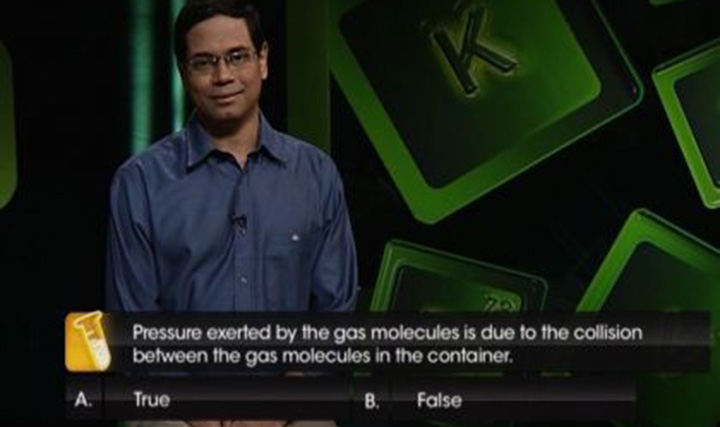 This video explains gas laws and ideal gas equation, its applications and limitations
This video explains gas laws and ideal gas equation, its applications and limitations -
States of Matter
 This video contains practice questions and numerical problems on the ideal gas equation.
This video contains practice questions and numerical problems on the ideal gas equation. -
States of Matter
 This video explains the deviation of real gases from ideal behaviour and compressibility factor for a non-ideal gas.
This video explains the deviation of real gases from ideal behaviour and compressibility factor for a non-ideal gas. -
States of Matter
 This video explains the liquefaction of gases and critical behaviour of gases.
This video explains the liquefaction of gases and critical behaviour of gases. -
States of Matter
 This video contains practice questions based on deviation of real gases from ideal behaviour and critical behaviour of gases.
This video contains practice questions based on deviation of real gases from ideal behaviour and critical behaviour of gases. -
States of Matter
 This video explains intermolecular forces in three states of matter and vapour pressure of liquids.
This video explains intermolecular forces in three states of matter and vapour pressure of liquids. -
States of Matter
 This video explains surface tension and viscosity of liquids.
This video explains surface tension and viscosity of liquids. -
States of Matter
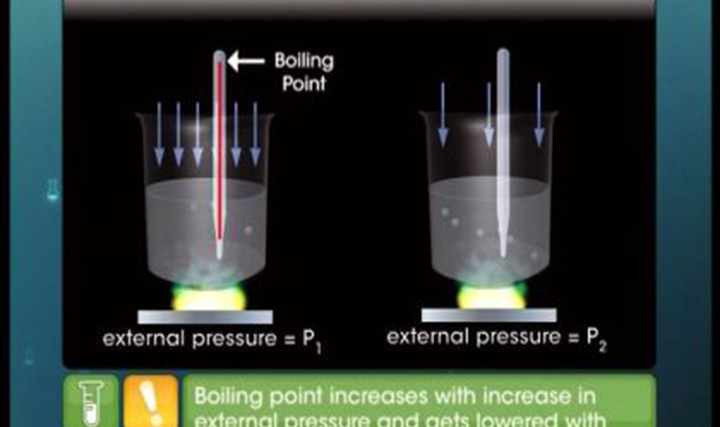 This video contains practice questions on properties of liquid such as vapour pressure, surface tension and viscosity.
This video contains practice questions on properties of liquid such as vapour pressure, surface tension and viscosity. -
States of Matter - Schottky Defect
 This video explains the Schottky defect in a crystal. It provides information about changes that takes place in this defect and examples of the Schottky defect.
This video explains the Schottky defect in a crystal. It provides information about changes that takes place in this defect and examples of the Schottky defect. -
States of Matter - Frenkel Defect
 This video explains the Frenkel defect in a crystal. It provides information about changes that takes place in this defect and examples of the Frenkel defect.
This video explains the Frenkel defect in a crystal. It provides information about changes that takes place in this defect and examples of the Frenkel defect. -
States of Matter - Boyle's Law
 This video includes condition for the Boyle's law, it's formula and graphs.
This video includes condition for the Boyle's law, it's formula and graphs. -
States of Matter - Avogadro's Law
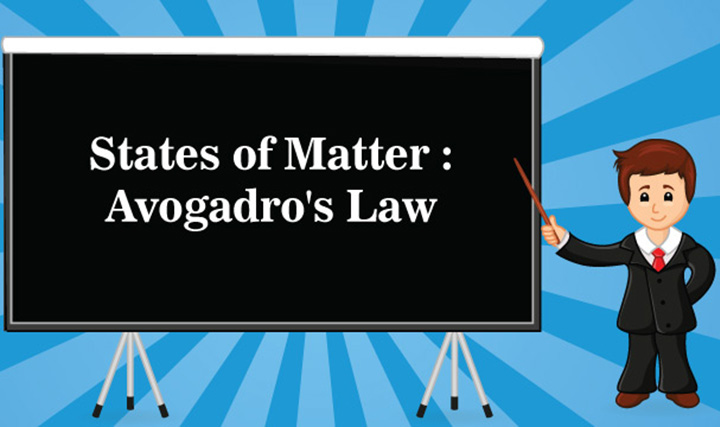 This video includes condition for the Avogadro 's law, it's formula and graphs.
This video includes condition for the Avogadro 's law, it's formula and graphs. -
States of Matter - Gay Lussac Law
 This video includes condition for the Gay Lussac's law, it's formula and graphs.
This video includes condition for the Gay Lussac's law, it's formula and graphs. -
States of Matter - Ideal Gas Equation
 This video includes the Ideal gas equation and it's another form. It also provides information about the value and units of gas constant.
This video includes the Ideal gas equation and it's another form. It also provides information about the value and units of gas constant. -
Concepts related to crystalline and amorphous solids
 This video deals with the concepts related to crystalline and amorphous solids.
This video deals with the concepts related to crystalline and amorphous solids. -
More on crystalline and amorphous solids
 This video explains important concepts related to crystalline and amorphous solids.
This video explains important concepts related to crystalline and amorphous solids. -
Crystalline and Amorphous Solids
 Crystalline and amorphous solids
Crystalline and amorphous solids -
Close packing in 3 dimensions

Close packing in 3Dimensions (a) Hexagonal close packing (b) Cubic close packing
-
Close Packing in 3D
 This video explains Close packing in 3Dimensions (a) Hexagonal close packing (b) Cubic close packing.
This video explains Close packing in 3Dimensions (a) Hexagonal close packing (b) Cubic close packing. -
Closed Packed Structures - Exam Decoded
 This video explains Close packing in 3D.
This video explains Close packing in 3D. -
Packing efficiency of ccp, bcc and simple cubic unit cell.
 Derivation and calculation of packing efficiency of ccp, bcc and simple cubic unit cell.
Derivation and calculation of packing efficiency of ccp, bcc and simple cubic unit cell. -
Building Blocks in Solids
 This video explains derivation and calculation of packing efficiency of ccp, bcc and simple cubic cell.
This video explains derivation and calculation of packing efficiency of ccp, bcc and simple cubic cell. -
Close packing in crystals
 This video is based on the derivation and calculation of packing efficiency of ccp, bcc and simple cubic unit cell.
This video is based on the derivation and calculation of packing efficiency of ccp, bcc and simple cubic unit cell. -
About Crystal Lattice
 Relation between cell edge & distance between atoms. Calculate volume & mass of unit cell and relate the same to calculate density of unit cells.
Relation between cell edge & distance between atoms. Calculate volume & mass of unit cell and relate the same to calculate density of unit cells. -
Relation between cell edge & distance between atoms
 Relation between cell edge & distance between atoms. Calculate volume & mass of unit cell and relate the same to calculate density of unit cells.
Relation between cell edge & distance between atoms. Calculate volume & mass of unit cell and relate the same to calculate density of unit cells. -
Crystal Lattice

Relation between cell edge & distance between atoms. Calculate volume & mass of unit cell and relate the same to calculate density of unit cells.
-
Relation between radius and cell edge
 This video explains the relationship between Cell edge and radius of atoms and ways to calculate the density of unit cells.
This video explains the relationship between Cell edge and radius of atoms and ways to calculate the density of unit cells. -
Relation between Cell edge and radius of atoms
 Relation between Cell edge and radius of atoms and calculate the density of unit cells.
Relation between Cell edge and radius of atoms and calculate the density of unit cells. -
Strategies on Dimensions of Unit cells
 This video explains the relation between Cell edge and radius of atoms and calculate the density of unit cells.
This video explains the relation between Cell edge and radius of atoms and calculate the density of unit cells. -
Stoichiometric and non - stochiometric defects in solid
 Stoichiometric and non - stochiometric defects in solid, define semiconductors & conductors. Understand magnetic properties in solids.
Stoichiometric and non - stochiometric defects in solid, define semiconductors & conductors. Understand magnetic properties in solids. -
Stoichiometric and non - stochiometric defects in solid
 Stoichiometric and non - stochiometric defects in solid, define semiconductors & conductors. Understand magnetic properties in solids.
Stoichiometric and non - stochiometric defects in solid, define semiconductors & conductors. Understand magnetic properties in solids. -
Crystalline and Amorphous Solids
 This video explains crystalline and amorphous solids and classification.
This video explains crystalline and amorphous solids and classification.
JEE Main Study Material
JEE Main study material includes video lessons, previous years’ question papers, webinars, JEE Main syllabus and JEE Advanced syllabus. These study resources are detailed and can help students give their best shot at the examination. The resources are updated regularly, and we ensure that no aspirant is behind in their preparation. Going through our detailed and planned study material and solving as many of our practice questions as possible will take students a long way. Not just that, our webinars allow students to interact with our subject matter experts and they can raise their doubts during the session. Students can also ask questions in our Ask a Doubt section at any time
Why should you prepare online for JEE Main with TopperLearning?
- You can prepare in the comfort of your home.
- E-learning saves you the time from browsing multiple books.
- Online classes is the new norm and the future of education.
- Saves time and energy which will be spent on commuting.
- Resources are available 24/7.



